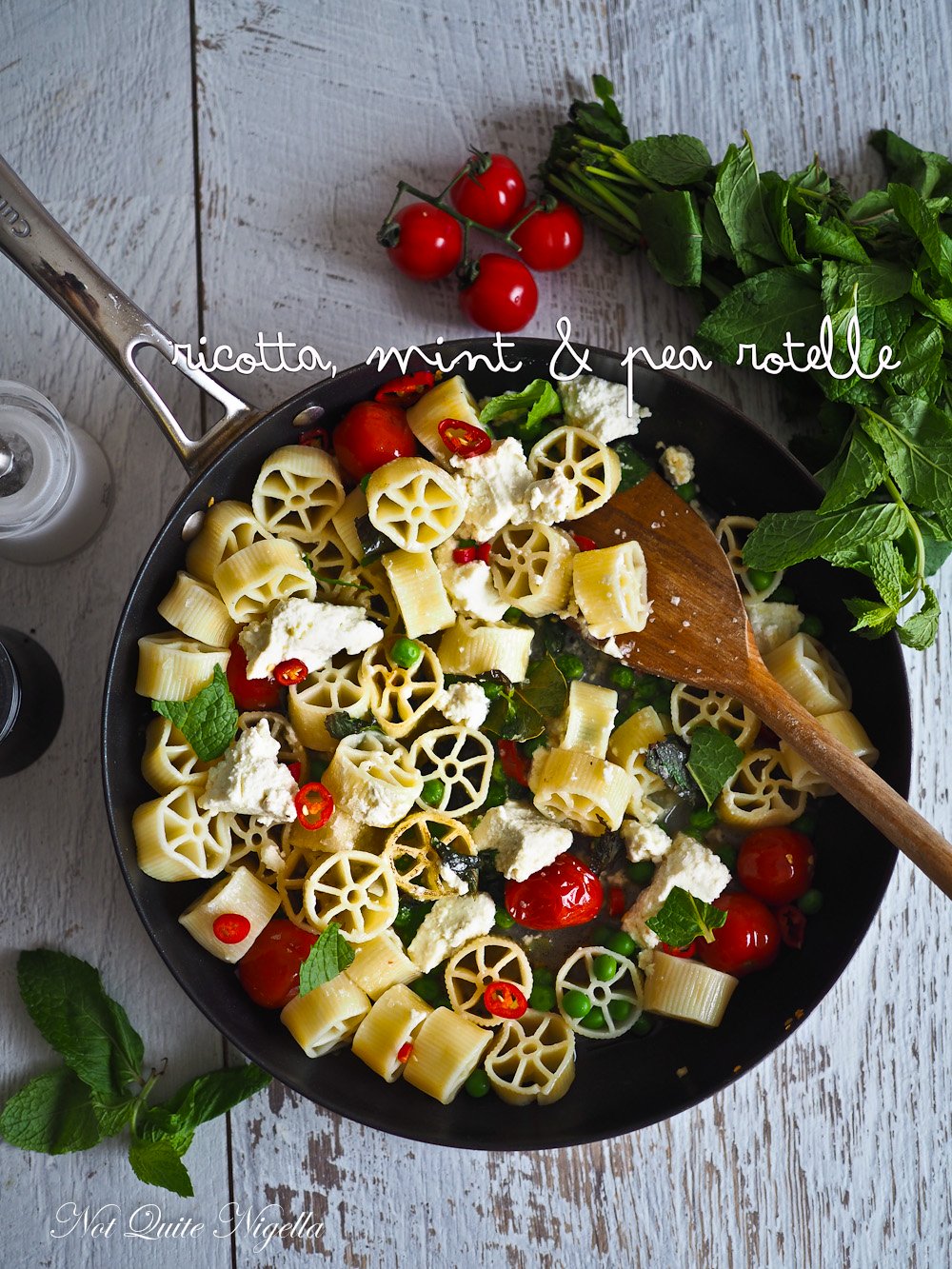Italian pasta comes in many shapes and sizes, each with its own unique characteristics and uses. Whether you enjoy a simple spaghetti with tomato sauce or a complex lasagna, understanding the different types of pasta can elevate your culinary experience.
Exploring these 45 types of Italian pasta will help you find the perfect match for your favorite recipes and enhance your cooking skills. Discover how various pasta shapes work with different sauces and ingredients to create delicious and authentic Italian dishes.
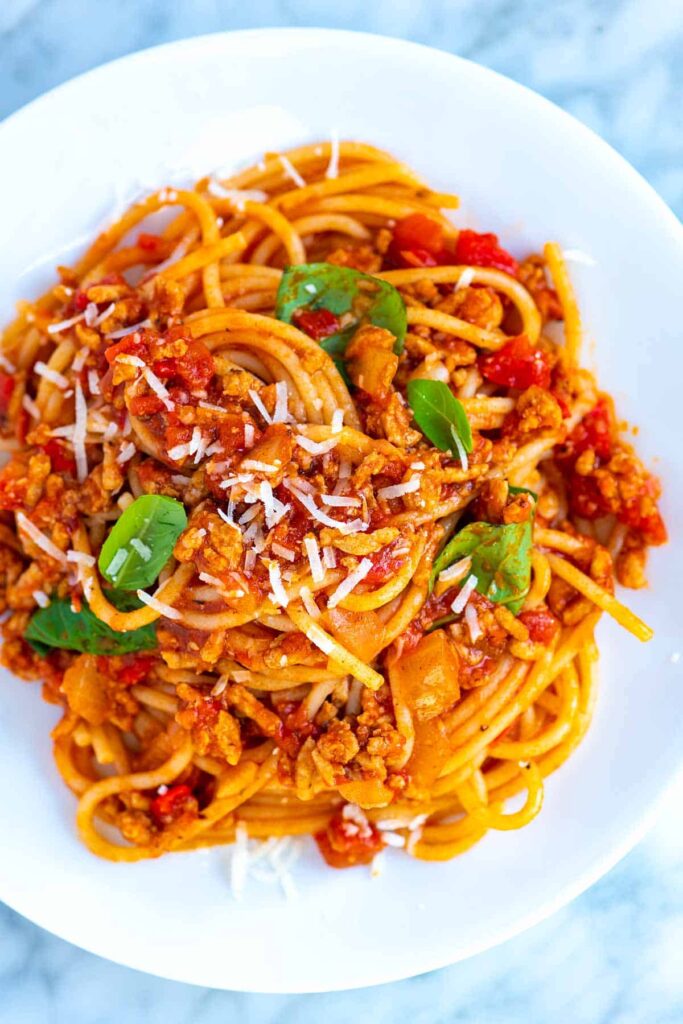
1) Spaghetti
Spaghetti is one of the most popular pasta types. It is a long, thin, round noodle. You can find it in many Italian dishes worldwide.
Spaghetti is easy to cook and works well with a variety of sauces. Traditional sauces include marinara, Bolognese, and carbonara.
You can also use spaghetti in cold salads or simple olive oil and garlic dishes. The noodles are great for soaking up flavors.
Spaghetti is typically made from durum wheat semolina. It can also come in whole wheat and gluten-free versions.
When cooking spaghetti, remember to use a large pot with plenty of water. This prevents the noodles from sticking together. Cook until al dente, which means the pasta is firm to the bite.
Draining spaghetti well is important. You may leave a little cooking water in the pot to help the sauce stick better to the noodles.
Spaghetti pairs well with seafood, meats, and vegetables. You can create endless variations of this versatile pasta.
Understanding spaghetti and how to cook it can elevate your pasta dishes. Experiment with different sauces and ingredients to find your favorite combinations.
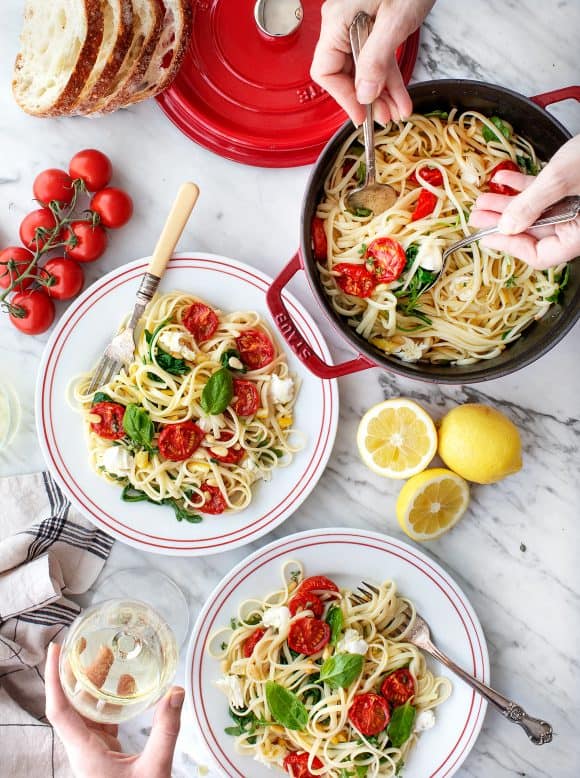
2) Linguine
Linguine is a type of long pasta that you might often see paired with seafood dishes. It’s wider than spaghetti but thinner than fettuccine, making it unique in texture and appearance.
This pasta is traditionally used in Italian cuisine, especially with clam sauces, known as Linguine alle Vongole. The width of linguine allows it to hold light or medium-weight sauces well.
Linguine works well with tomato-based sauces and vegetable mixes. You may also find it combined with pesto or creamy Alfredo sauces. The slightly flattened shape helps the pasta catch and hold more sauce compared to round pasta.
When cooking linguine, ensure you don’t overcook it. Al dente is the preferred texture, meaning it should still be firm to the bite. You can find linguine labeled as “linguini” in some places, but it refers to the same pasta type.
Whether you’re making a classic Italian meal or experimenting with new flavors, linguine is a versatile and reliable choice for a variety of dishes.
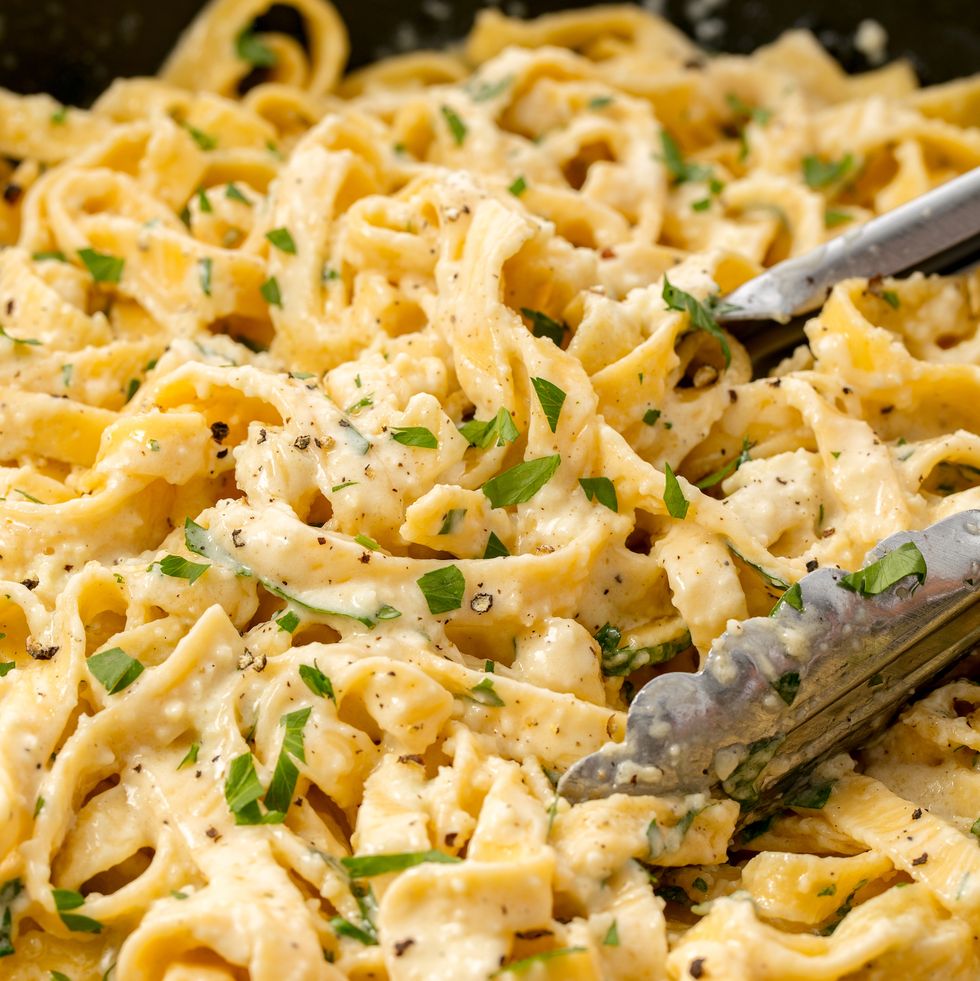
3) Fettuccine
Fettuccine is a well-known type of Italian pasta. It’s made up of long, flat ribbons. This shape holds sauce well, making it ideal for rich and creamy sauces.
You might find fettuccine served with Alfredo sauce. This combination is popular and delicious. You can also pair it with meat sauces, like ragu.
Fettuccine has a unique texture. It’s thicker than spaghetti or linguine. This gives it a hearty bite that many people enjoy.
Making fettuccine at home can be fun. You can use a pasta maker to roll out the dough into even strips. Fresh pasta typically cooks faster than dried pasta.
This pasta comes from the regions of Italy, specifically Lazio and Tuscany. Its name means “little ribbons” in Italian. Remember, when cooking fettuccine, it’s best to follow the package instructions for the perfect al dente texture.
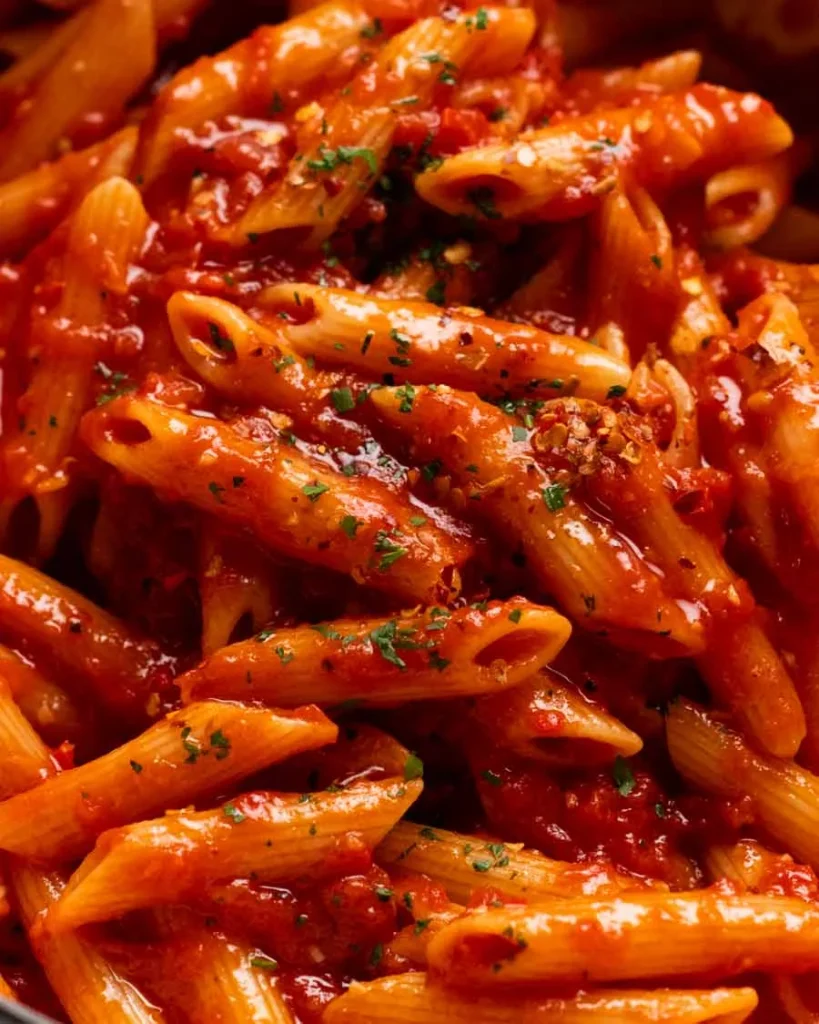
4) Penne
Penne is one of the most popular types of pasta. It is tubular in shape with diagonal ends that resemble quills or pens. This unique shape helps it hold sauces well, making it versatile in many dishes.
You can find penne in two variations: smooth (lisce) and ridged (rigate). Ridged penne is better at capturing and holding onto thicker sauces, while smooth penne works well with lighter, cream-based sauces.
When cooking penne, it’s essential to use plenty of water and salt. Italians often use about 100 grams of pasta per person. This ensures the pasta cooks evenly and absorbs enough flavor from the water.
Penne is commonly used in baked casseroles like pasta al forno and creamy dishes like penne alla vodka. Its solid structure makes it ideal for holding up under baking and combining with hearty ingredients.
Whether you’re making a simple pasta salad or a rich, comforting baked dish, penne is a reliable choice. Its adaptability in various recipes makes it a staple in many households.
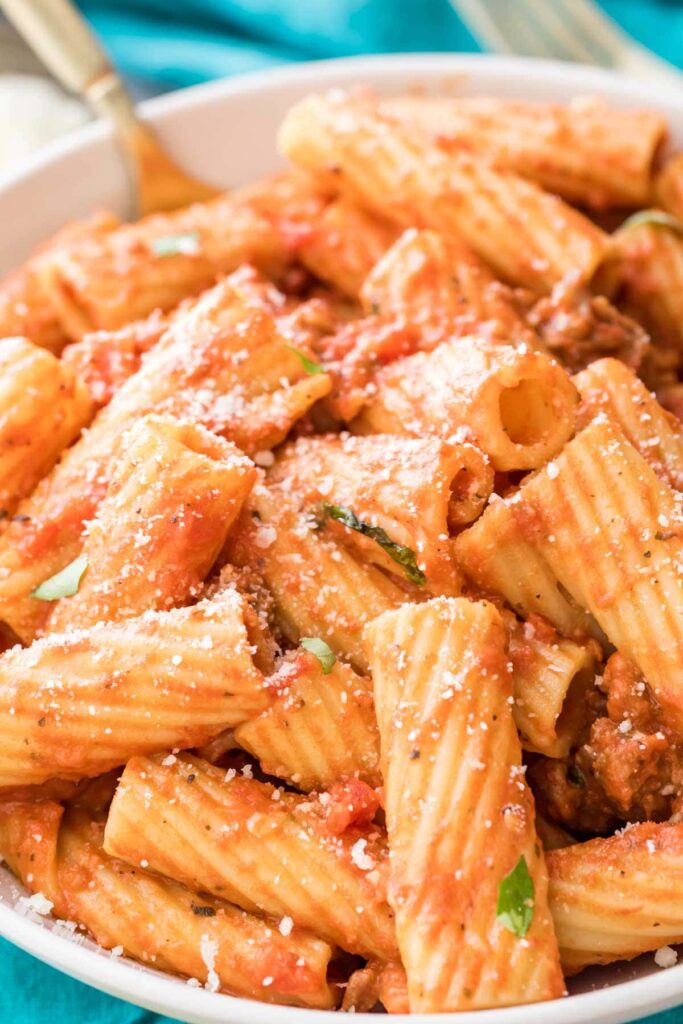
5) Rigatoni
Rigatoni is a type of short pasta known for its ridged, tube-like shape. The name “Rigatoni” comes from the Italian word “rigare,” which means “to rid.” This design helps hold onto sauces, making each bite full of flavor.
You can use Rigatoni in many dishes. It pairs well with thick, chunky sauces like Bolognese or sausage ragu. The ridges and hollow center make it perfect for capturing every bit of sauce.
Cooking Rigatoni is simple. Boil it in salted water until al dente, usually about 10-12 minutes. This pasta also works well in baked dishes like casseroles and pasta bakes, where it retains its shape and texture even after oven cooking.
Next time you’re planning a meal, consider Rigatoni. Its versatility and ability to hold sauces make it a great choice for hearty, flavorful dishes. Whether you’re making a simple tomato sauce or a rich meat sauce, Rigatoni won’t disappoint.
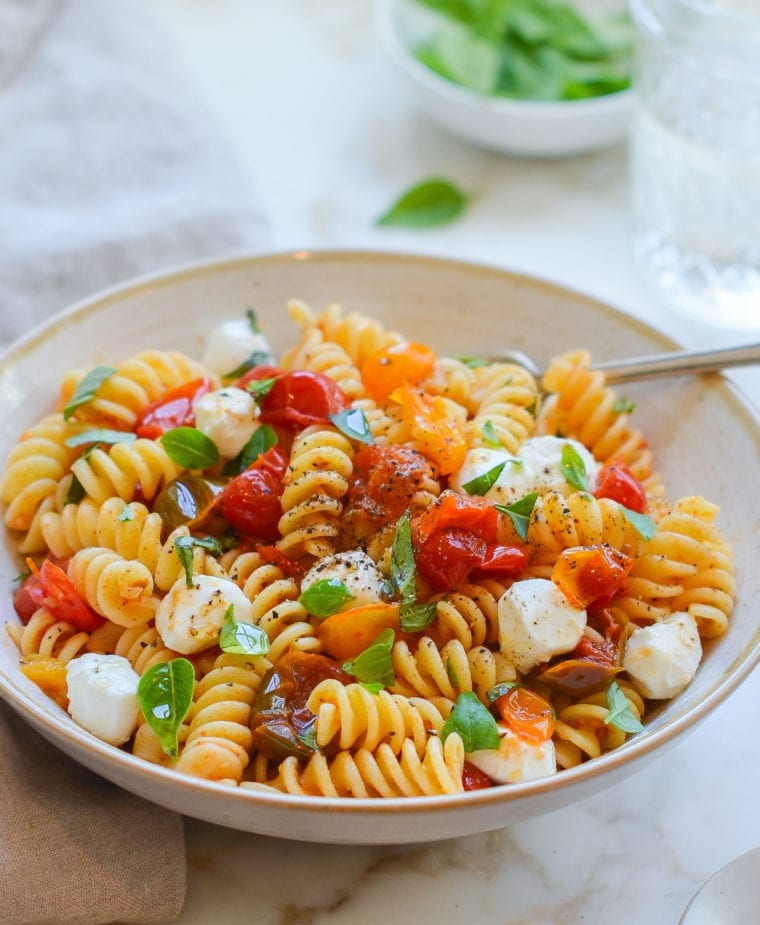
6) Fusilli
Fusilli is a type of Italian pasta known for its spiral shape. The twists in fusilli make it perfect for holding onto sauces. This pasta is versatile and suits a wide range of dishes.
You can use fusilli in both hot and cold recipes. It’s great for pasta salads because its shape captures dressing and ingredients well.
When cooking fusilli, it typically takes about 10-12 minutes to achieve the right texture. You can pair it with tomato-based sauces, cream sauces, and pesto. Its shape holds onto thick and chunky sauces wonderfully.
Fusilli is also a good choice for baked pasta dishes. It works well in casseroles, as the sauce clings to the spirals during baking.
For a simple dish, try fusilli with sautéed vegetables and a sprinkle of cheese. Another delicious option is fusilli with a lemon and herb dressing.
This type of pasta is often made from wheat flour and water. Some versions use whole wheat, providing a slightly nutty flavor and a bit more texture.
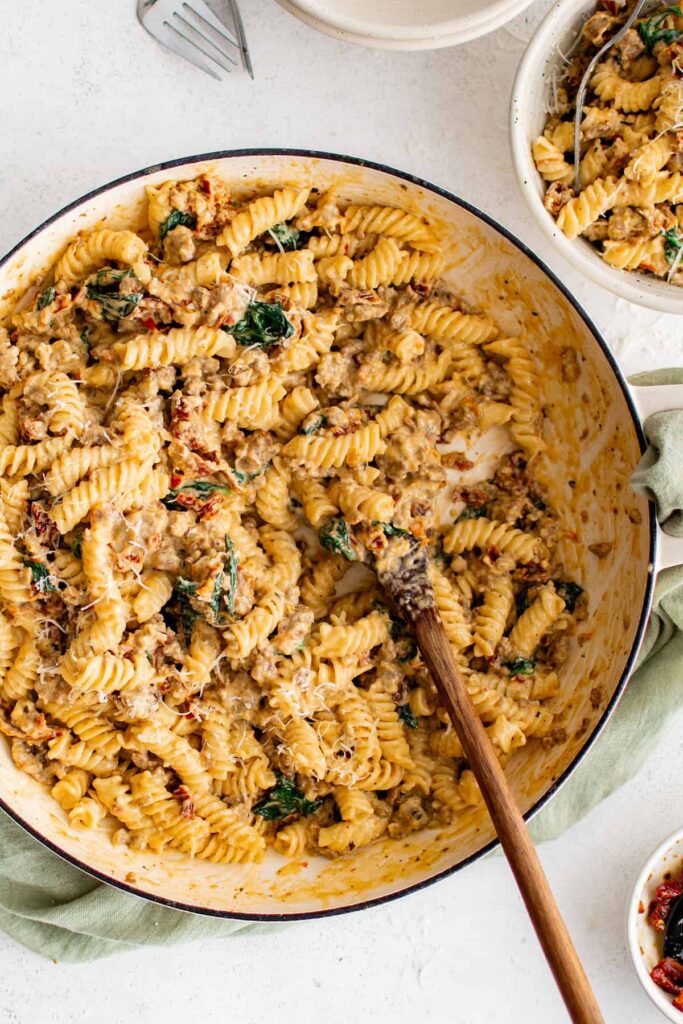
7) Rotini
Rotini is a type of pasta that stands out with its corkscrew shape. This spiral design helps it hold onto sauces very well. It’s often made with durum wheat, giving it a firm texture that’s perfect for many dishes.
Rotini pairs nicely with both thick and thin sauces. It works great with tomato-based sauces, meaty ragus, and creamy Alfredo. The shape ensures each bite is flavorful and satisfying.
This pasta is also excellent in pasta salads. Its twists trap bits of vegetables, cheese, and dressing. Tri-color rotini adds a colorful touch, making your dish visually appealing as well as tasty.
You can bake rotini in casseroles for a cozy meal. Mixing it with seasoned chicken, bacon, and cheese creates a hearty dish that everyone will love. The pasta’s shape helps it stay firm when baked, providing a pleasant texture.
Rotini is versatile and popular in many recipes. Whether you’re making a warm pasta dish or a refreshing salad, rotini always performs well. Its ability to hold sauces and other ingredients makes it a kitchen favorite.
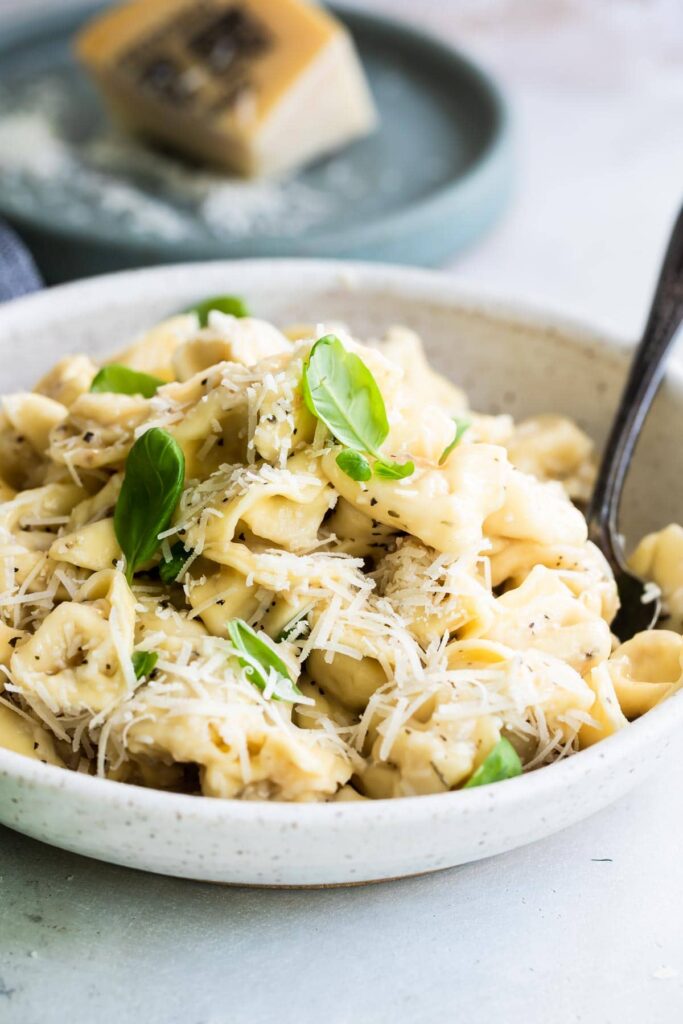
8) Tortellini
Tortellini are small ring-shaped pasta filled with a variety of ingredients. They are a famous Italian specialty, originating from the Emilia-Romagna region.
Filled with meats, cheeses, or vegetables, tortellini can be served in broth or with various sauces. Popular choices include tomato sauce, cream sauce, or pesto.
Fresh tortellini cook quickly, in just 3-4 minutes. Dried tortellini take a bit longer, around 5-7 minutes. Always check the package instructions for specific times.
You can try different variations like tortelloni, which are larger and often filled with unique ingredients such as seafood or mixed vegetables. Experiment with different fillings and sauces to find your favorite combination.
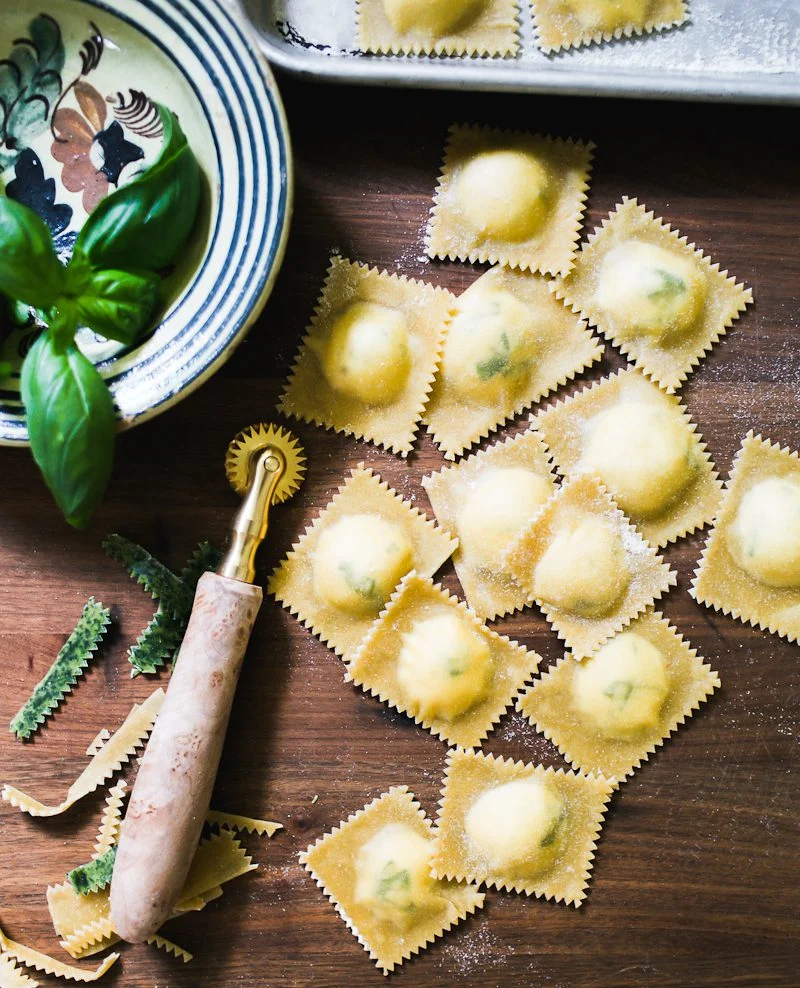
9) Ravioli
Ravioli are square or round pockets of pasta filled with a variety of ingredients. These pockets can be filled with cheese, meat, vegetables, or even seafood. The dough is usually made with flour, eggs, and water.
You can find ravioli served in a variety of sauces. Common options include tomato sauce, butter and sage, or even creamy sauces. The choice of sauce often depends on the filling. For example, cheese ravioli might go well with tomato sauce, while meat-filled ravioli may be served with a rich ragu.
Ravioli is known for its versatility. You can make it vegetarian with fillings like ricotta and spinach. If you prefer something more luxurious, try fillings such as lobster or foie gras. Seasonal ingredients like wild garlic are also popular.
Homemade ravioli can be a fun cooking project. You’ll need to roll out the pasta dough thinly, place small mounds of filling, and seal them with another layer of dough. Using a ravioli cutter or mold ensures uniform shapes.
Cooking ravioli is simple. Boil them in salted water until they float to the top. This usually takes just a few minutes. Then, toss them gently with your chosen sauce and serve immediately.
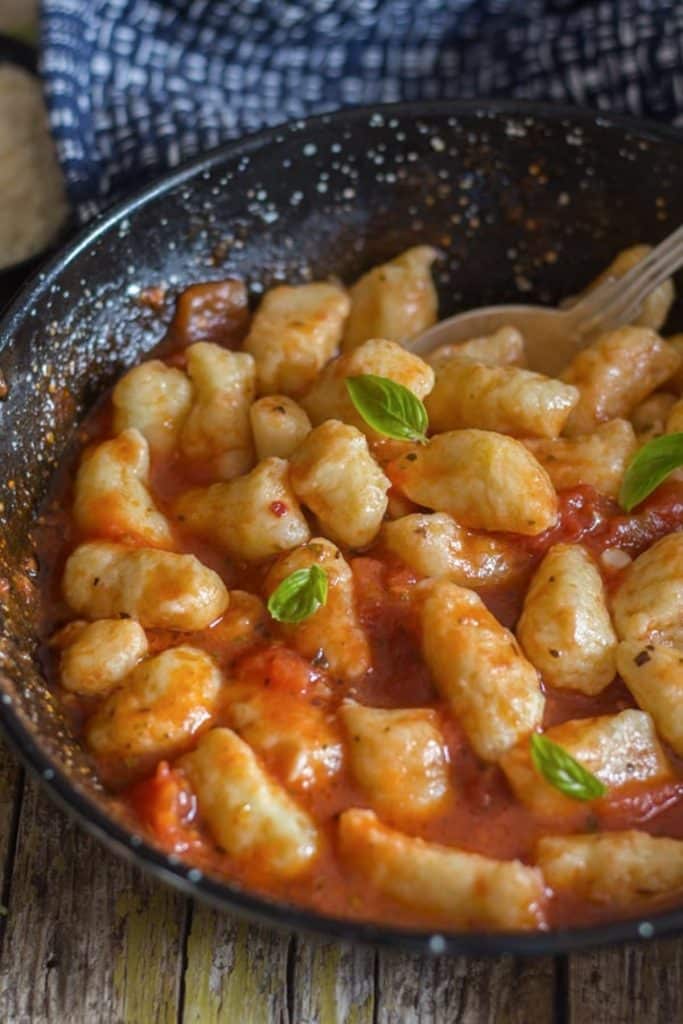
10) Gnocchi
Gnocchi are small, soft dumplings often made from potatoes, flour, and eggs. They are a beloved Italian comfort food, known for their light and fluffy texture.
You might find gnocchi served with a variety of sauces such as ragú, tomato, or butter sauce. Each sauce can highlight the dumplings’ chewy goodness in a unique way.
In different regions of Italy, there are various types of gnocchi. For instance, canederli, also called bread gnocchi, are made with stale bread, milk, flour, and egg. These are common in the South Tirol region.
Another variety is malloreddus, also known as gnocchetti Sardi. Made from semolina and water, these are traditional to Sardinia and are often paired with sausage and fennel ragù.
When making gnocchi at home, it’s crucial to boil the potatoes with their skins on. This helps keep them from getting too wet. After boiling, they are peeled, mashed, and then mixed with the other ingredients into a dough before being shaped into dumplings.
Cooking gnocchi typically takes about 2-3 minutes in boiling water. They are ready when they float to the surface. You can then toss them with your preferred sauce for a simple yet satisfying meal.
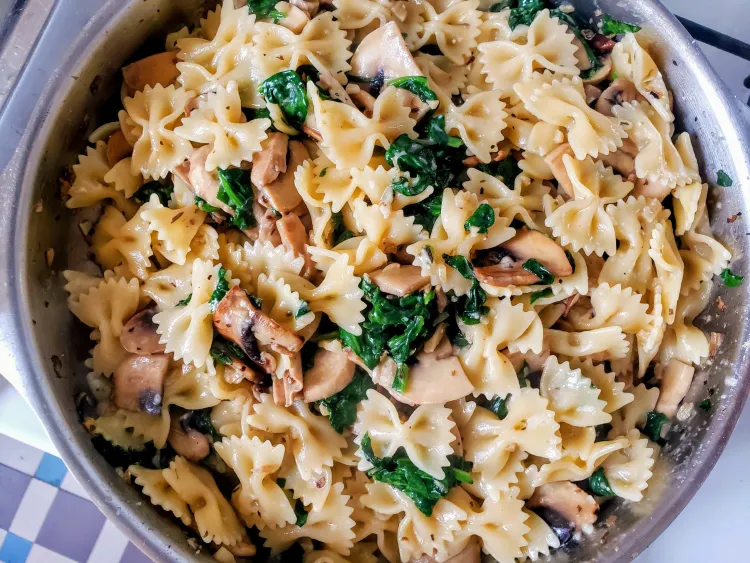
11) Farfalloni
Farfalloni is a larger version of the well-known farfalle or bow-tie pasta. Its name means “big butterflies” in Italian, referring to its shape. Farfalloni has soft ridges that help sauces cling to it better.
You can pair farfalloni with tomato-based or cream-based sauces. The ridges and large surface area hold these sauces well, making every bite flavorful.
This pasta is excellent in hearty dishes. It goes well in baked pasta recipes or robust soups, adding texture and making the dish more filling.
When cooking farfalloni, ensure you let it boil until it’s al dente. This keeps the pasta from becoming too soft and losing its shape.
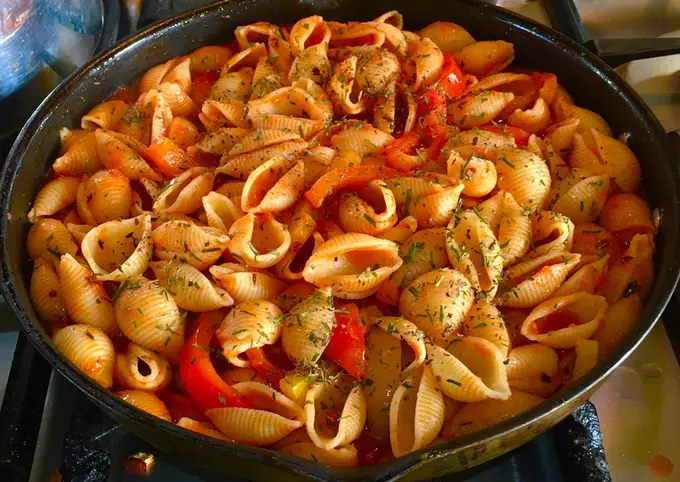
12) Conchiglie
Conchiglie, or shell pasta, comes in various sizes and shapes. The smallest size, conchigliette, is perfect for soups. Medium-sized conchiglie works well with thick sauces.
The largest size, conchiglioni, is ideal for stuffing and baking. You can fill these jumbo shells with cheese, meats, or vegetables.
This pasta’s shape helps hold sauce, providing a flavorful bite. Use it to make a hearty dish that everyone will enjoy.
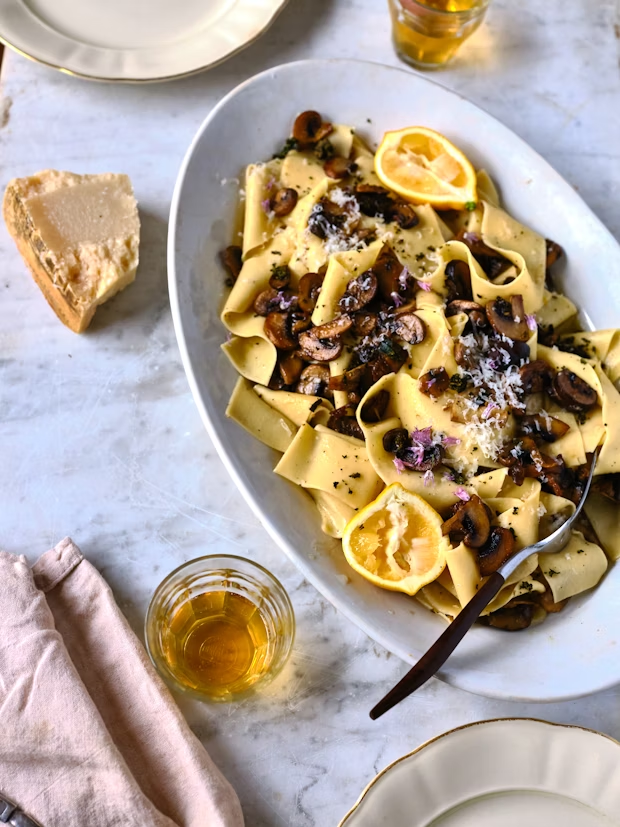
13) Pappardelle
Pappardelle is a type of broad, flat pasta. Its name comes from the Italian word “pappare,” which means “to gobble up.” This pasta is perfect for hearty sauces.
You often see pappardelle paired with rich, meaty sauces. A classic combination is pappardelle with a slow-cooked ragù, such as a beef or pork ragù.
Pappardelle also works well with vegetable-based sauces. For instance, a mushroom and spinach sauce can bring out the best in this pasta.
This pasta is usually made from durum wheat flour and water. Its wide shape allows it to hold onto thick sauces, making every bite flavorful.
You can find pappardelle in both fresh and dried forms. Fresh pappardelle has a tender texture, while dried pappardelle is more firm and chewy.
Making pappardelle at home is also an option. You can roll out the dough and cut it into wide ribbons. Fresh homemade pappardelle can have a more delicate texture.
In summary, pappardelle is versatile and pairs beautifully with a variety of sauces. Whether you choose a meaty ragù or a lighter vegetable sauce, pappardelle can elevate your dish.
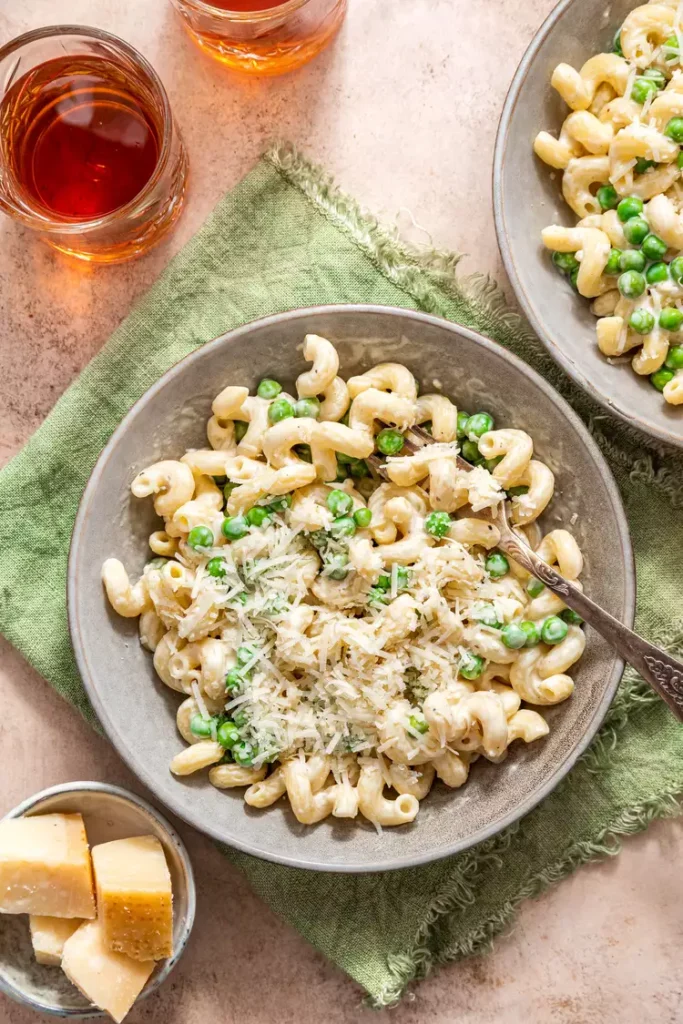
14) Cavatappi
Cavatappi is a spiral-shaped pasta that resembles a corkscrew. Its name means “corkscrew” in Italian. This pasta has a thick and ridged surface, making it perfect for holding onto sauces.
You can use cavatappi in various dishes, from creamy Alfredo to rich tomato-based sauces. The ridges and twists catch every bit of sauce, offering a tasty bite every time.
Cavatappi works well in baked dishes, such as casseroles and pasta bakes. Its shape helps it stay firm, even after baking. You can also enjoy it in cold pasta salads, where it adds fun texture and holds onto dressing and other ingredients.
This pasta pairs nicely with a variety of toppings, including vegetables, meats, and cheeses. It is versatile enough for gourmet recipes or simple weeknight dinners. Whether you’re whipping up a quick meal or cooking for a special occasion, cavatappi adds a unique twist to your pasta dishes.
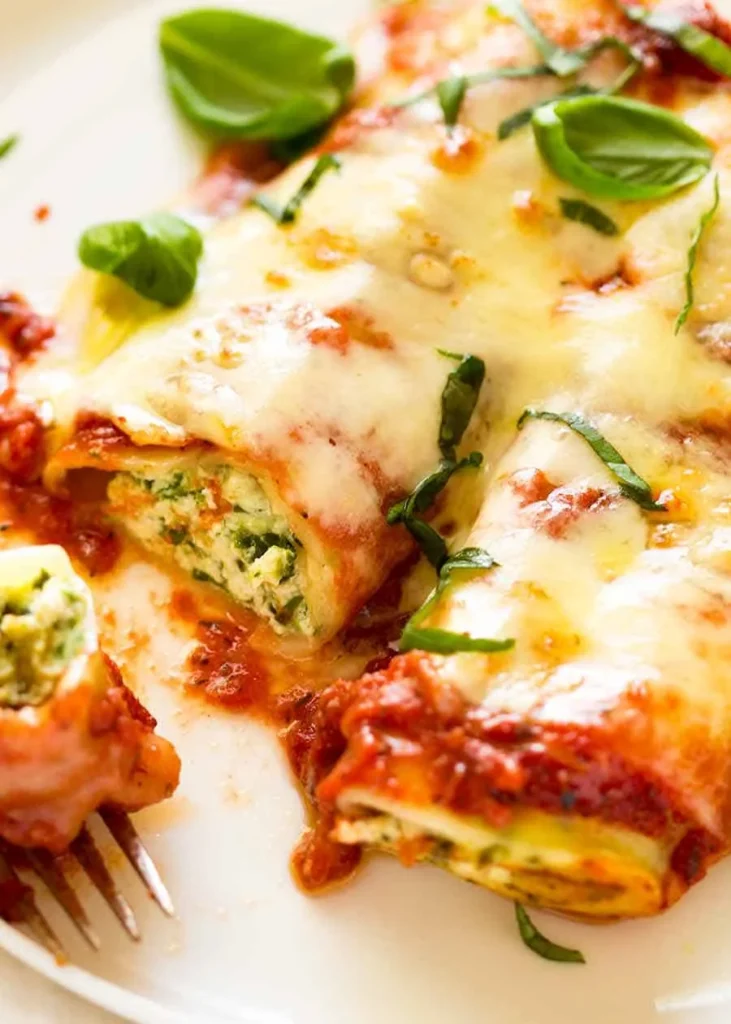
15) Cannelloni
Cannelloni are large, cylindrical pasta tubes perfect for stuffing. You typically fill them with a mixture of meats, cheeses, or vegetables. After stuffing, you cover the tubes with sauce and bake them.
A popular filling is ricotta cheese mixed with spinach. You can also add spices like nutmeg and grated cheese for added flavor.
When making the dough, use one egg for every 2/3 cup of flour. If the dough is too dry, add water. If it’s too wet, add more flour.
For the best results, let the dough rest before rolling. After stuffing the cannelloni, bake them until they’re golden and bubbly on top.
Cannelloni are versatile, allowing for creativity with fillings. You can use ingredients you have on hand to make a delicious meal.
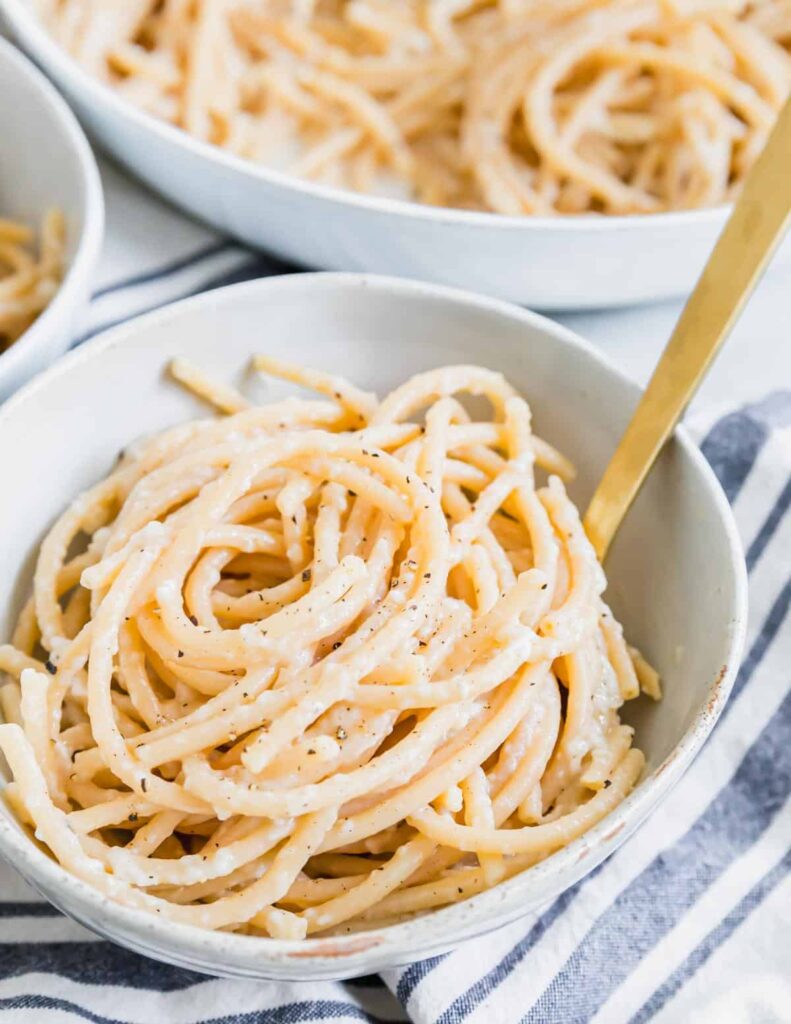
16) Bucatini
Bucatini is a unique type of pasta that looks similar to spaghetti but has a small hole running through the center. This makes it perfect for capturing sauces, adding an extra burst of flavor with every bite. Bucatini is slightly thicker and rounder than spaghetti, giving it a hearty texture.
Traditional recipes often pair bucatini with robust sauces. The hole in the pasta helps to hold creamy or chunky sauces, ensuring that you get a satisfying taste with each forkful. It’s commonly used in classic Italian dishes like Bucatini all’Amatriciana, where it’s coated in a rich, tomato-based sauce with pancetta.
Bucatini is also great for baked dishes and soups. The hollow center allows it to absorb flavors from broths and casseroles, making it a versatile pasta for various recipes. You can try it with seafood sauces, especially those containing sardines or cuttlefish ink, following traditional Neapolitan methods.
When cooking bucatini, ensure that you stir it occasionally to prevent sticking. It typically takes 8-10 minutes to reach the desired al dente texture. Once cooked, it can be tossed directly into your sauce, allowing the pasta to soak up all the delicious flavors.
Try experimenting with bucatini in different sauces, from classic marinara to creamy vodka sauce. Its unique structure makes it perfect for creative and traditional recipes alike.
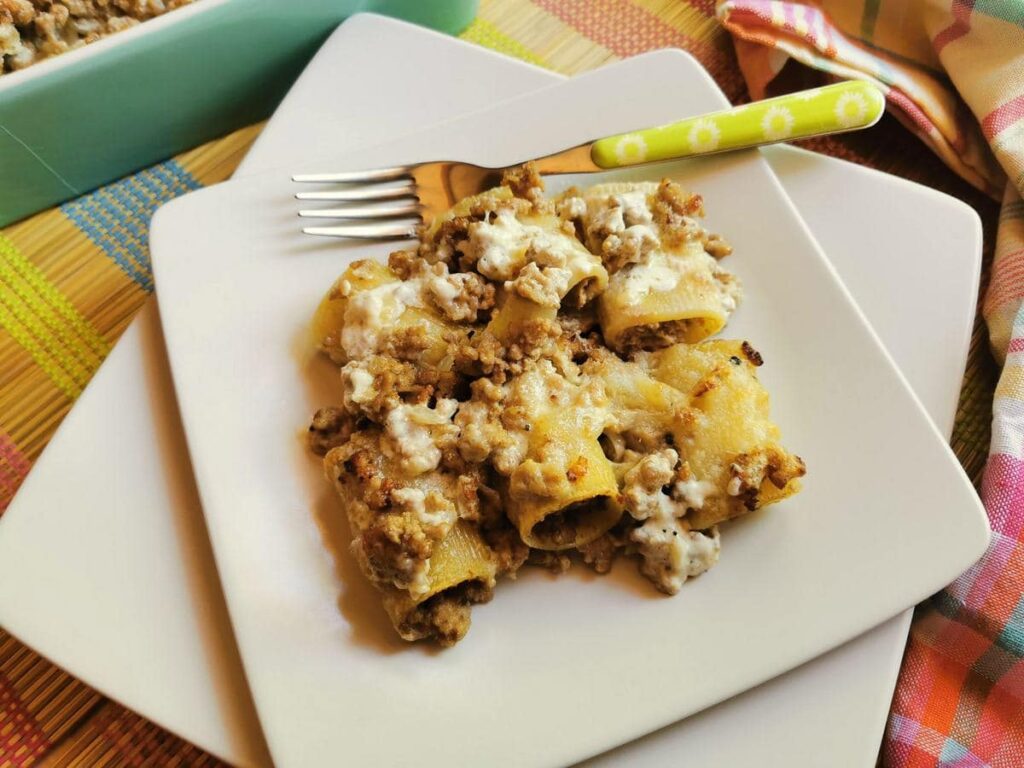
17) Maccheroni
Maccheroni is a type of pasta that’s tubular in shape. In Italy, the term refers to different kinds of durum wheat semolina pasta. The tubes can be long or short and vary in thickness.
You might know this pasta by its more common name, “macaroni.” It is often used in dishes like mac and cheese. The pasta is dried and has a central hole running through it.
When cooking Maccheroni, simmer it for 8-12 minutes. It should be tender but still a bit firm. Pair it with tomato sauce, meat sauces, or creamy Alfredo sauce.
Maccheroni works well in both simple and hearty dishes. Try it in casseroles or baked dishes, where it can absorb plenty of flavors. This versatility makes it a favorite in many kitchens.
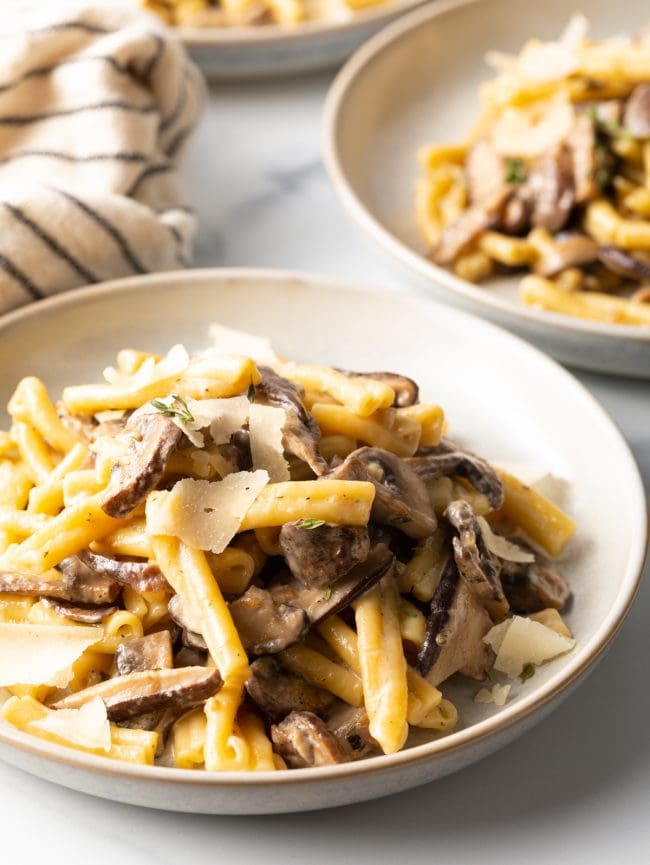
18) Gemelli
Gemelli is a short, twisted pasta that resembles two strands wrapped around each other. This unique shape holds sauces well, making it perfect for various dishes.
You can pair gemelli with tomato sauce, creamy Alfredo, or zesty pesto. It works great in pasta salads with vegetables and a tangy vinaigrette.
Try gemelli with chicken, broccoli, and a garlic sauce for a satisfying meal. Its shape ensures each bite is full of flavor. Experiment by adding different ingredients like tomatoes, Parmesan, or even walnuts for a delightful crunch.
Gemelli is also easy to cook. Boil it in salted water until al dente, then toss with your favorite sauce. It’s versatile, making it a favorite in many kitchens.
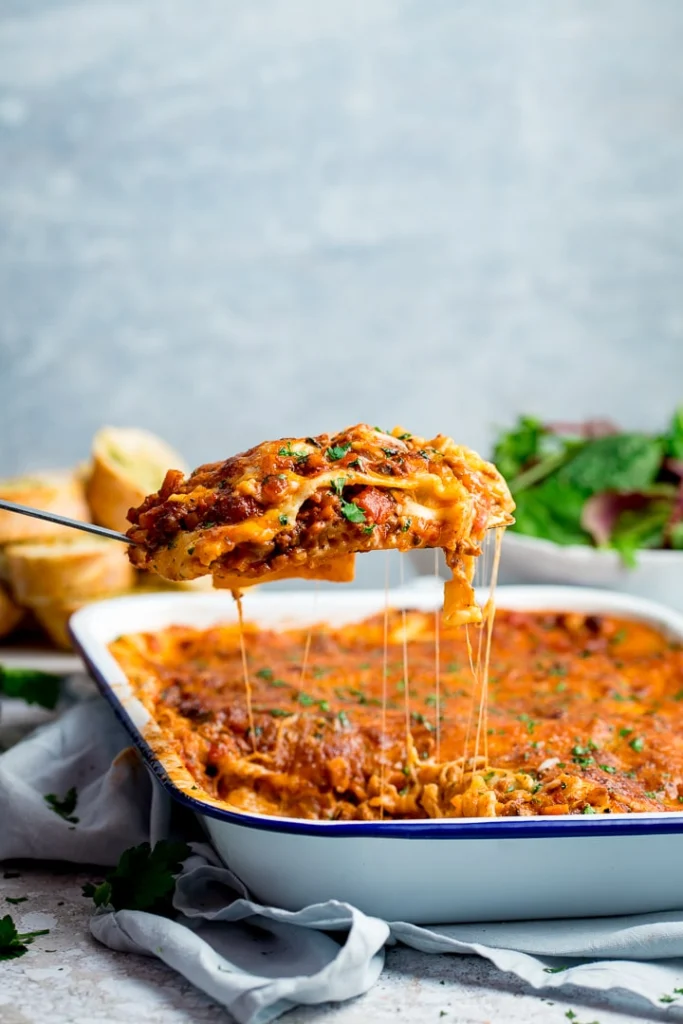
19) Lasagne
Lasagne is a popular type of pasta that consists of wide, flat sheets. These sheets are layered with various fillings and baked in the oven.
You will find lasagne in many regions of Italy, each with its unique twist. For example, in Emilia-Romagna, lasagne is often made with green spinach pasta.
When making lasagne, you can use meat sauces, vegetable mixtures, or creamy bechamel. Cheese like mozzarella and ricotta are common additions.
Lasagne’s versatility makes it a great choice for both meat lovers and vegetarians. You can also make it ahead of time and reheat it, making it perfect for gatherings.
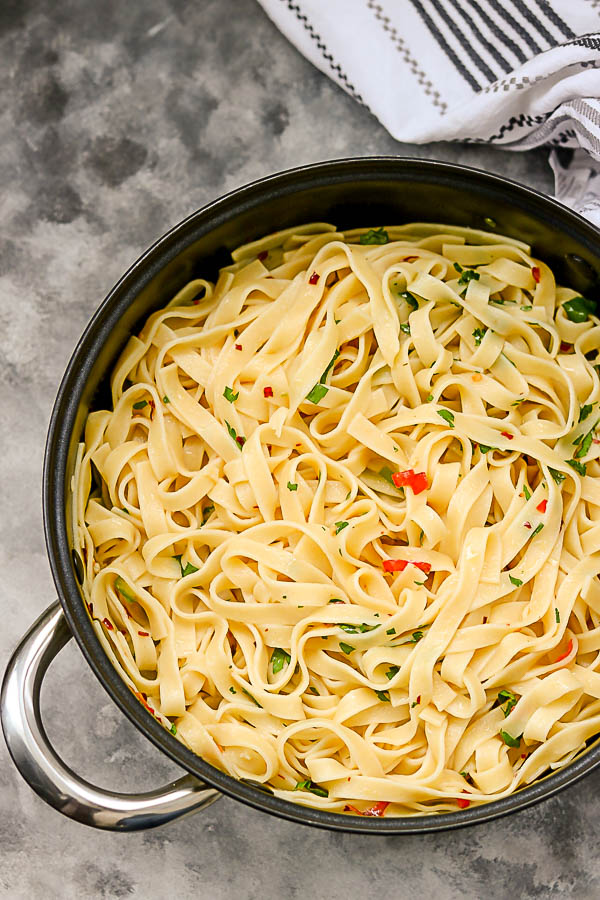
20) Tagliatelle
Tagliatelle is a classic Italian pasta known for its long, flat ribbons. It originates from the Emilia-Romagna and Marche regions of Italy. The name comes from the Italian word “tagliare,” which means “to cut.”
You can use tagliatelle with a variety of sauces, but it is especially good with hearty meat sauces like Bolognese. Its wide surface area helps to hold onto thicker sauces.
Tagliatelle is often made with eggs, giving it a rich flavor and smooth texture. You can also find it dried or fresh, depending on your preference. Fresh tagliatelle cooks very quickly, while dried takes a bit longer.
In Italian cuisine, tagliatelle is typically paired with simple ingredients to let the pasta shine. Try it with butter, sage, or a light tomato sauce. Whether you choose a complicated or simple preparation, tagliatelle is versatile and delicious.
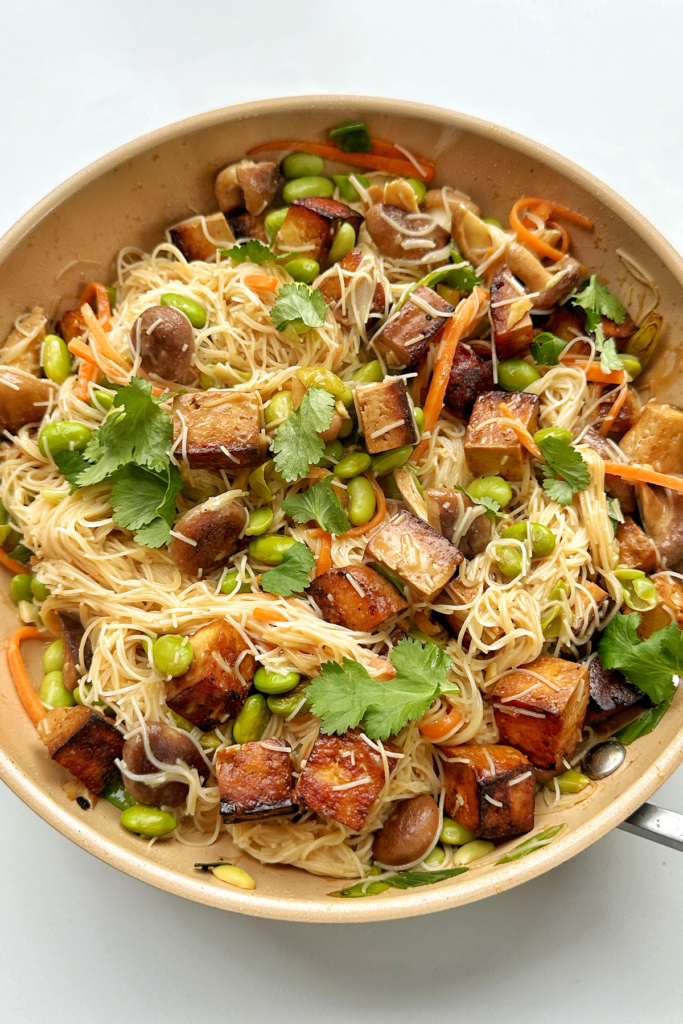
21) Vermicelli
Vermicelli, meaning “little worms” in Italian, is a type of thin, round noodle. In Italy, traditional vermicelli is thicker than spaghetti.
In the U.S., vermicelli is usually thinner than spaghetti but thicker than angel hair pasta.
You often find vermicelli in soups, salads, and casseroles. Its delicate texture pairs well with light and elegant sauces.
Vermicelli is also used worldwide. In Asia, it’s common in rice noodles, while in Mexico, it appears in fideo soups.
If you’re cooking vermicelli, remember it cooks quickly due to its thinness. This makes it a great choice for speedy meals.
Whether in a main dish or a side, vermicelli’s versatility makes it a popular pasta.
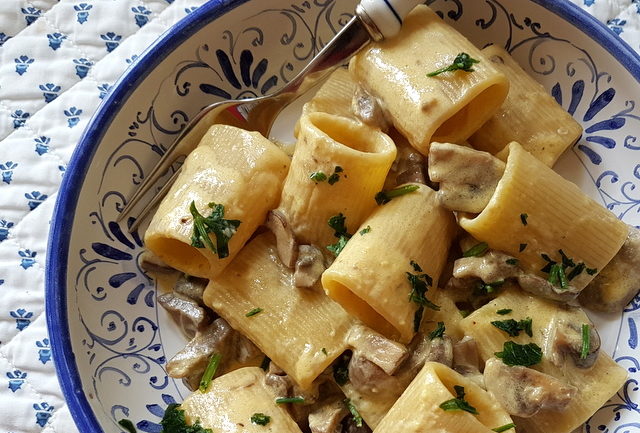
22) Paccheri
Paccheri is a large, tube-shaped pasta that originates from southern Italy. It’s particularly popular in Naples. These wide, smooth tubes are perfect for holding hearty sauces and ingredients.
You can prepare Paccheri with various sauces. Tomato-based sauces and rich meat sauces are especially common. The large size also makes it ideal for stuffing with cheese, meats, or vegetables.
Paccheri works well in oven-baked dishes. The pasta holds its shape, so you can layer it in casseroles or bake it with a savory filling. It’s also delicious with seafood, such as shrimp or clams.
Fresh Paccheri can be made at home. You need simple ingredients like flour, eggs, and a pinch of salt. Knead the dough until smooth, let it rest, then roll and cut into large tubes.
Using dried Paccheri is also an option. Just follow the package instructions to cook it until al dente. Pair with your favorite sauce or stuffing for a satisfying meal.
Paccheri’s versatility and hearty nature make it a favorite in Italian cuisine. Whether filled, baked, or simply mixed with a rich sauce, it’s always a hit.
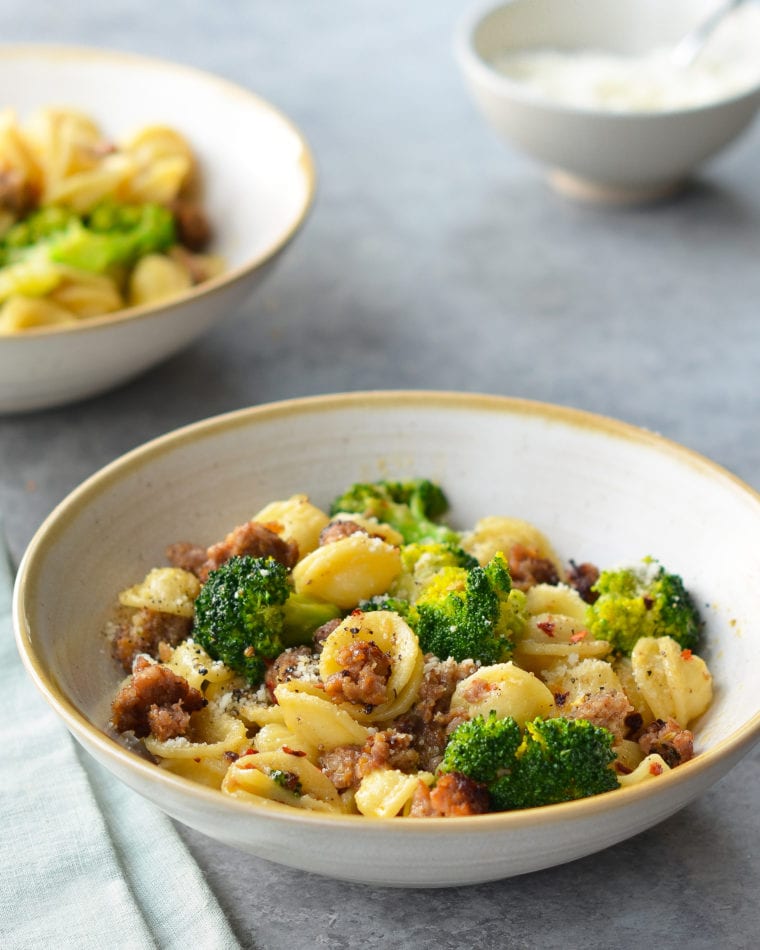
23) Orecchiette
Orecchiette, pronounced oh-reck-ee-ET-tay, is a pasta from the Puglia region in southeastern Italy. This area is known as the “heel” of Italy’s boot. The name “orecchiette” means “little ears” in Italian, which describes the pasta’s unique ear-like shape.
To make orecchiette at home, you’ll need semolina flour and warm water. Mix these ingredients until you form a firm dough. Knead the dough for about 10 minutes until it’s smooth and elastic. Then, let it rest for at least 15 minutes.
After resting, roll the dough into a long snake, about 1 centimeter thick. Cut it into small pieces and use your thumb to press each piece, giving it the signature ear shape. Fresh orecchiette has a different texture and taste compared to dried ones, though both are widely available.
Orecchiette pairs well with chunky sauces. It’s often served with broccoli rabe, sausage, or meat ragù. The small, cup-like shape holds sauces beautifully, making each bite flavorful.
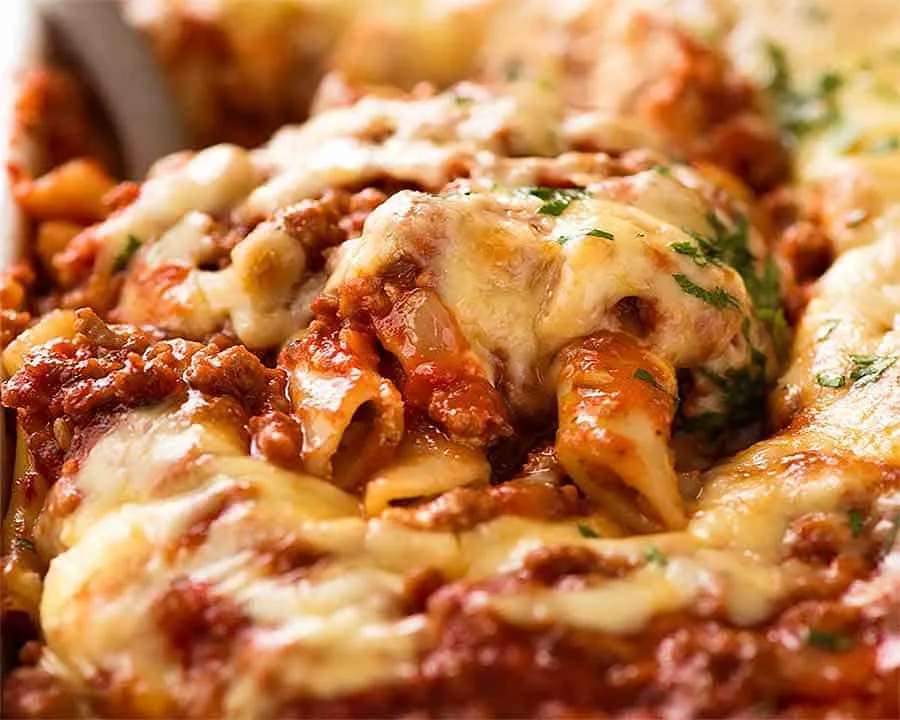
24) Ziti
Ziti is a popular type of Italian pasta known for its smooth, tube-like shape. It is commonly used in baked dishes and pairs well with hearty sauces. Ziti is similar to penne but without the ridges.
You often find ziti in baked pasta recipes like Baked Ziti, where it is mixed with tomato sauce, cheese, and sometimes meat. This pasta holds its shape well, making it perfect for baking.
When cooking ziti, you should boil it until it is al dente, or firm to the bite. This helps it maintain its texture during baking. Ziti’s smooth surface allows sauces to cling well, creating a flavorful dish.
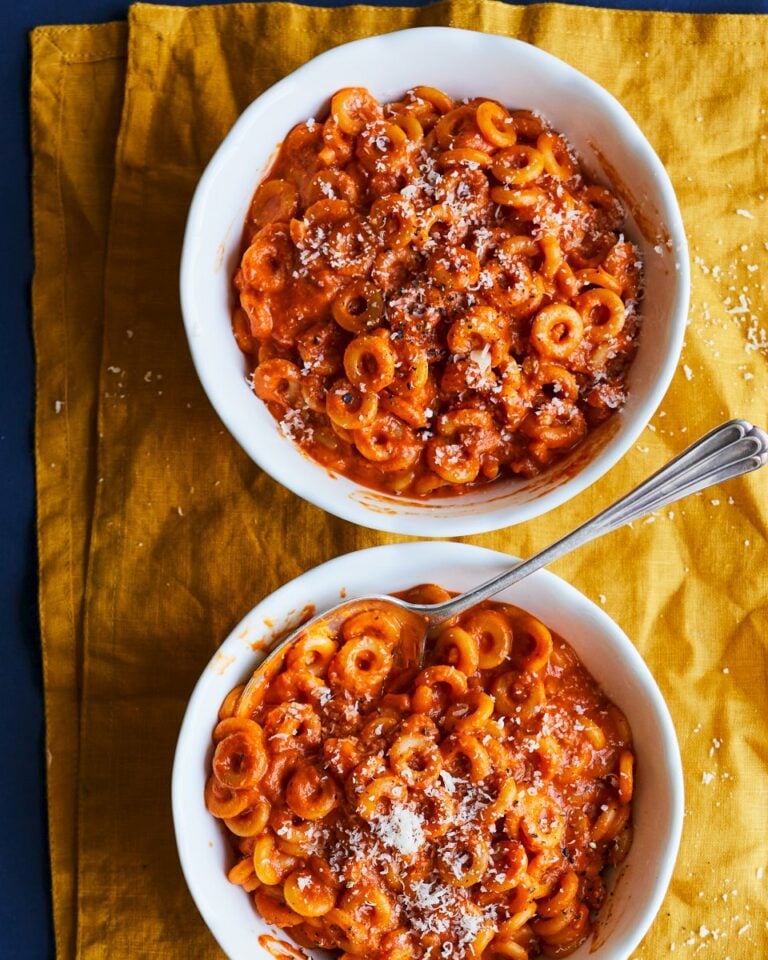
25) Anelli
Anelli, meaning “little rings” in Italian, is a type of pasta known for its small, ring-like shape. This pasta is popular in Southern Italy and comes in various thicknesses and textures, including smooth and ridged.
You can prepare Anelli by boiling it in salted water until it reaches an al dente texture. This pasta shape is versatile and works well in many dishes.
Anelli is often used in soups, adding a chewy bite that complements broth-based recipes. It can also be baked in casseroles for a heartier meal.
You might find Anelli paired with different sauces like marinara, pesto, or arrabbiata. Its ring shape holds sauces well, making every bite flavorful.
For a unique twist on pasta, try Anelli in cold pasta salads. Its shape and size make it a fun and tasty addition to picnic dishes.
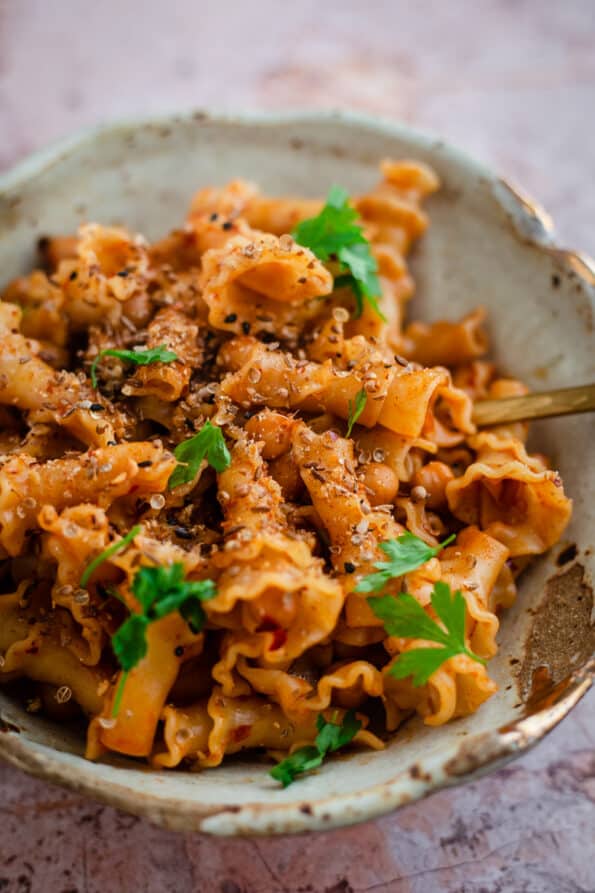
26) Gigli
Gigli pasta, also known as campanelle or riccioli, originates from Campania, Italy. Its name means “lilies” in Italian. The pasta pieces are shaped like small cones with ruffled edges, resembling bell flowers or curls.
Made from durum wheat semolina, gigli pasta is sturdy and holds its shape well. It is dried and packaged after being kneaded and rolled into thin sheets.
The shape of gigli makes it perfect for holding sauces. The fluted edges and hollow center allow sauces to cling to the pasta, providing a flavorful bite every time. You can pair it with rich, chunky sauces like Bolognese or creamy sauces with vegetables.
Gigli’s unique shape also makes it a great addition to pasta salads. It adds an interesting texture and captures bits of other ingredients, enhancing each mouthful.
Whether you use it in baked dishes or served with a simple tomato and basil sauce, gigli pasta is a versatile choice.
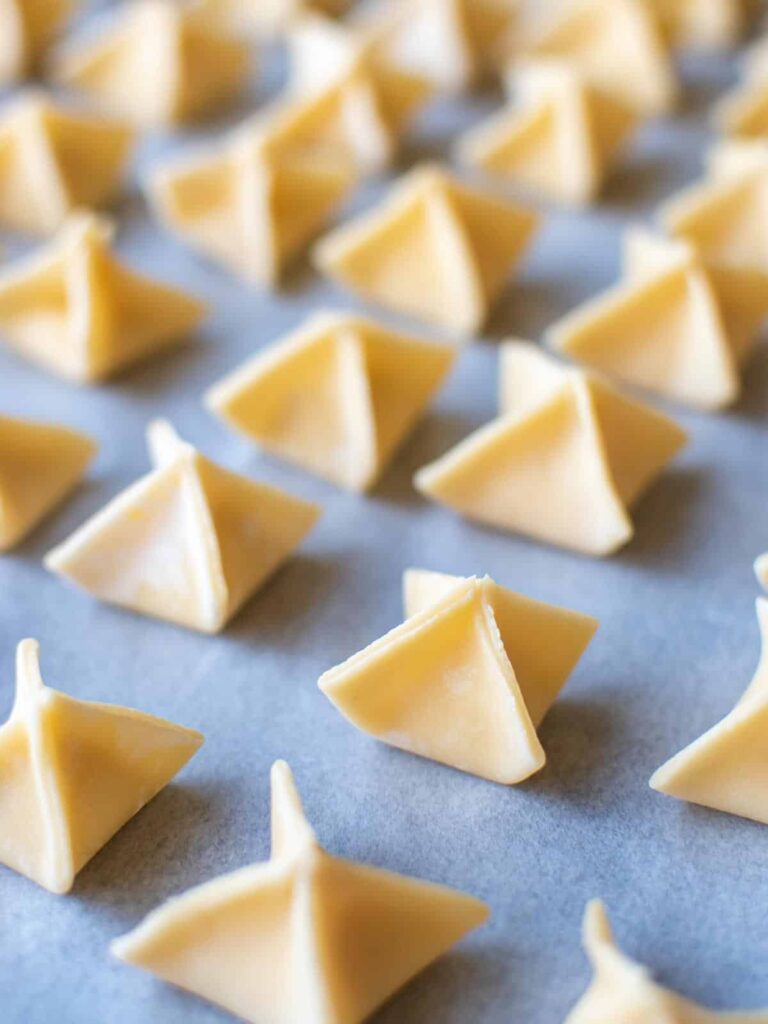
27) Fagottini
Fagottini is a delightful type of Italian pasta known for its unique shape and versatility. The name means “little bundles,” and it truly resembles small purses or sacks.
This pasta is often filled with ingredients like ricotta cheese, vegetables, or even fruits. Common fillings include carrots, green beans, truffles, or small pieces of fresh pear.
When making fagottini, you’ll often start with a straightforward pasta dough. Cut the dough into small squares using a pasta cutting wheel or a cookie cutter. Add a tiny amount of filling in the center, then fold and seal the edges.
Fagottini pairs well with light, thin sauces to highlight its delicate flavors. You can also serve it in broths for a comforting dish. The small size of each piece makes it perfect for an elegant presentation.
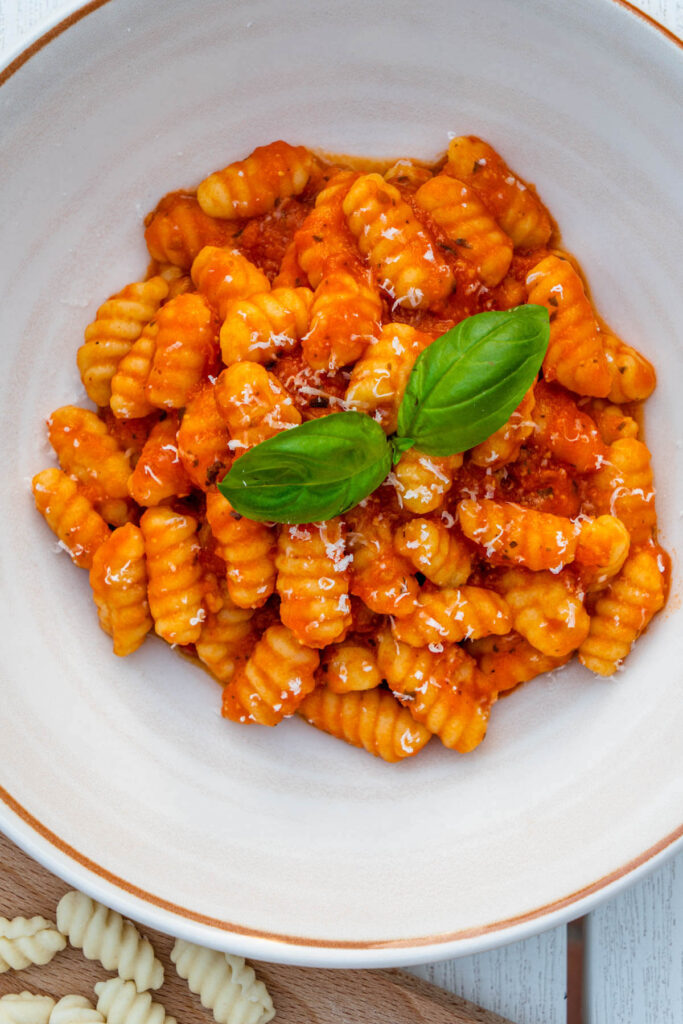
28) Malloreddus
Malloreddus, also known as “Sardinian gnocchi,” is a traditional pasta from Sardinia. This pasta is small, ridged, and shell-shaped.
To make malloreddus, you roll the dough into long, snake-like shapes. Then, you cut them into small pieces, around 1-2 cm each. After cutting, you press and roll each piece against a special board or the back of a fork.
Malloreddus is commonly served with rich meats and hearty sauces. A popular dish is Malloreddus alla Campidanese, where the pasta is paired with a sausage ragù. You cook the sauce with sausage, tomatoes, onions, garlic, and some spices.
This pasta goes well with thicker sauces because the ridges help hold the sauce well. This makes every bite full of flavor. You can also pair malloreddus with lamb ragu, using lamb, garlic, and bay leaves for a tasty meal.
Cooking malloreddus is easy. You bring a pot of salted water to a boil, add the pasta, and cook until it’s al dente. Drain and mix it with your sauce.
Malloreddus is a delightful pasta that can add a touch of Sardinian tradition to your meals.
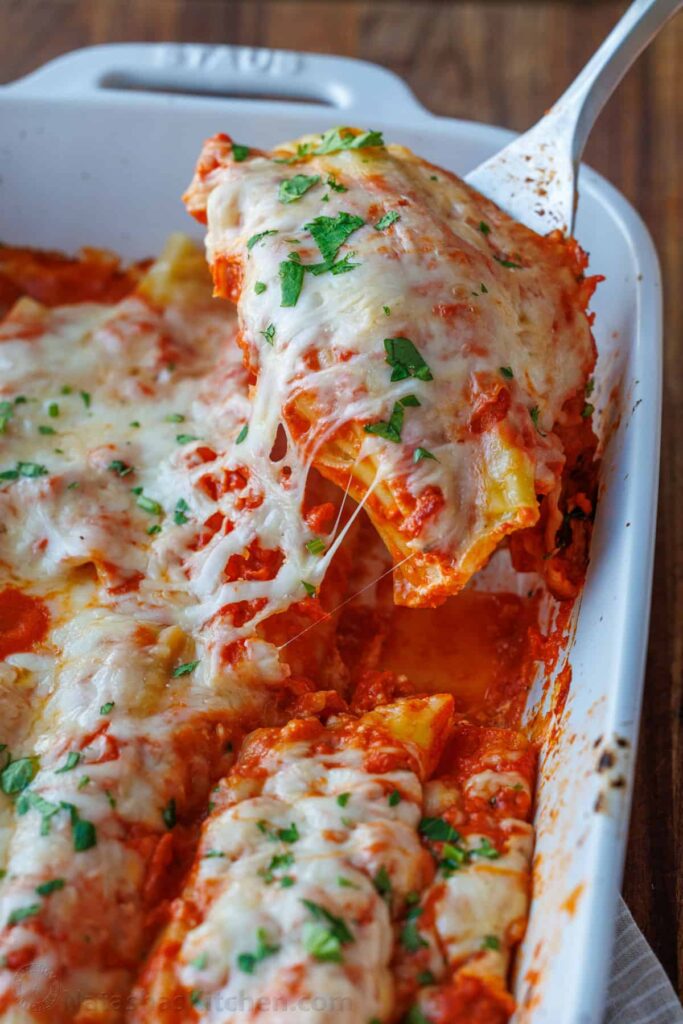
29) Manicotti
Manicotti is a type of pasta shaped like large tubes. These tubes are perfect for stuffing with various fillings. Traditionally, you might fill manicotti with cheese mixtures, such as ricotta, mozzarella, and Parmigiano Reggiano.
To prepare manicotti, you first cook the pasta until it’s slightly firm. Then, you fill it with your chosen stuffing.
After stuffing, place the manicotti in a baking dish and cover it with marinara sauce. This helps keep the pasta moist while it bakes.
Bake the manicotti at a moderate temperature, usually around 350°F to 375°F, until the filling is hot and the sauce is bubbly. This pasta dish is a favorite in many households and is often served during special occasions.
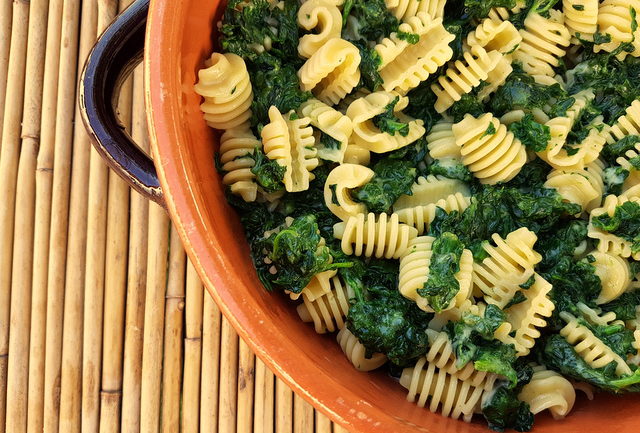
30) Radiatori
Radiatori pasta is a unique and relatively recent addition to the many types of pasta. This pasta shape was designed in the 1960s. Its name comes from its resemblance to the metallic grills of car radiators.
You will notice radiatori’s short, chunky shape with ruffled edges. This design helps the pasta hold onto sauces very well. The ruffled edges create lots of surface area, making it perfect for thicker, chunky sauces.
When cooking with radiatori, you can pair it with hearty and rich sauces. Think of meaty Bolognese or creamy Alfredo. The pasta’s texture and shape enhance these types of sauces.
You can also use radiatori in soups. Its shape makes it ideal for absorbing the flavors of the broth. Try adding it to a bowl of Italian sausage soup for a comforting meal.
For a lighter dish, use radiatori with olive oil, fresh herbs, and vegetables. This pasta can be tossed with ingredients like sun-dried tomatoes, peas, and parmesan for a simple yet delicious meal.
Experiment with radiatori in your favorite recipes. Its unique shape may become a new favorite in your kitchen.
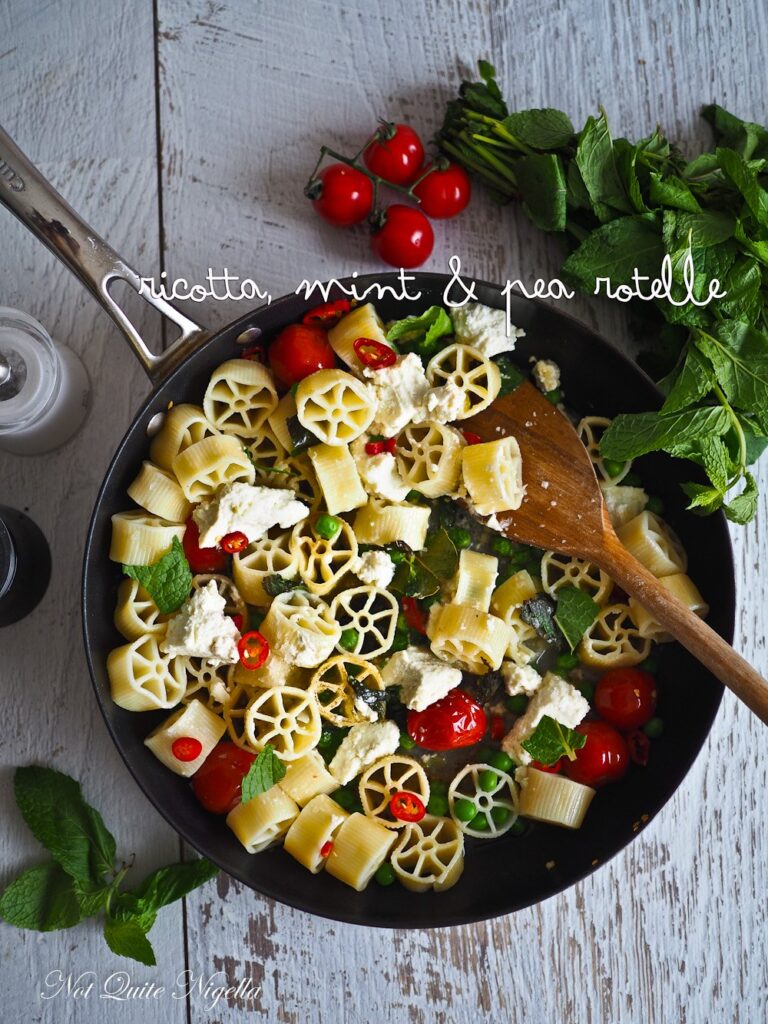
31) Rotelle
Rotelle, often referred to as “little wheels,” is a unique pasta shape that looks like miniature spoked wheels. Its distinctive form makes it excellent for holding onto sauces and flavors.
This pasta type pairs well with various sauces, from creamy Alfredo to hearty meat sauces. The spokes trap bits of meat, vegetables, or cheese, bringing more flavor with every bite.
To cook rotelle, simply boil it in salted water until al dente. This makes it perfect for pasta salads or baked dishes where you want the pasta to remain firm.
Rotelle is also a great choice for fun, kid-friendly meals. Its playful shape is sure to make any dish more interesting and enjoyable.
Feel free to experiment by mixing rotelle with different ingredients like sausages, fresh herbs, and cheeses. This pasta is versatile and can adapt to many culinary creations.
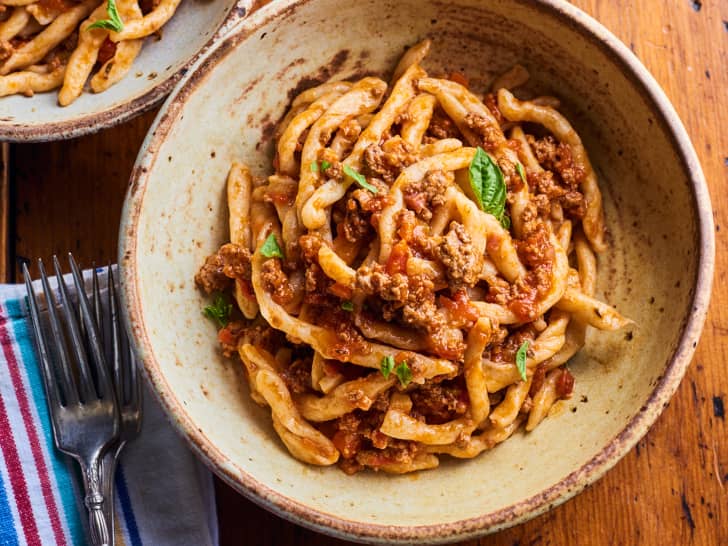
32) Strozzapreti
Strozzapreti, meaning “priest strangler” in Italian, is a hand-rolled pasta. This pasta type is common in regions like Emilia-Romagna, Tuscany, Marche, and Umbria.
To make strozzapreti, you roll out the dough to a thin sheet and cut it into long, narrow strips. You then roll these strips between your hands or around a stick to shape them.
Strozzapreti pairs well with thick, hearty sauces. Try it with a rich tomato sauce or a meat-based ragù.
You can also find strozzapreti dishes that include ingredients like pancetta, mushrooms, and garlic. These add great flavor and texture to the dish.
When cooking strozzapreti, make sure to salt the water well. Follow the package directions for cooking time to ensure it has the perfect texture.
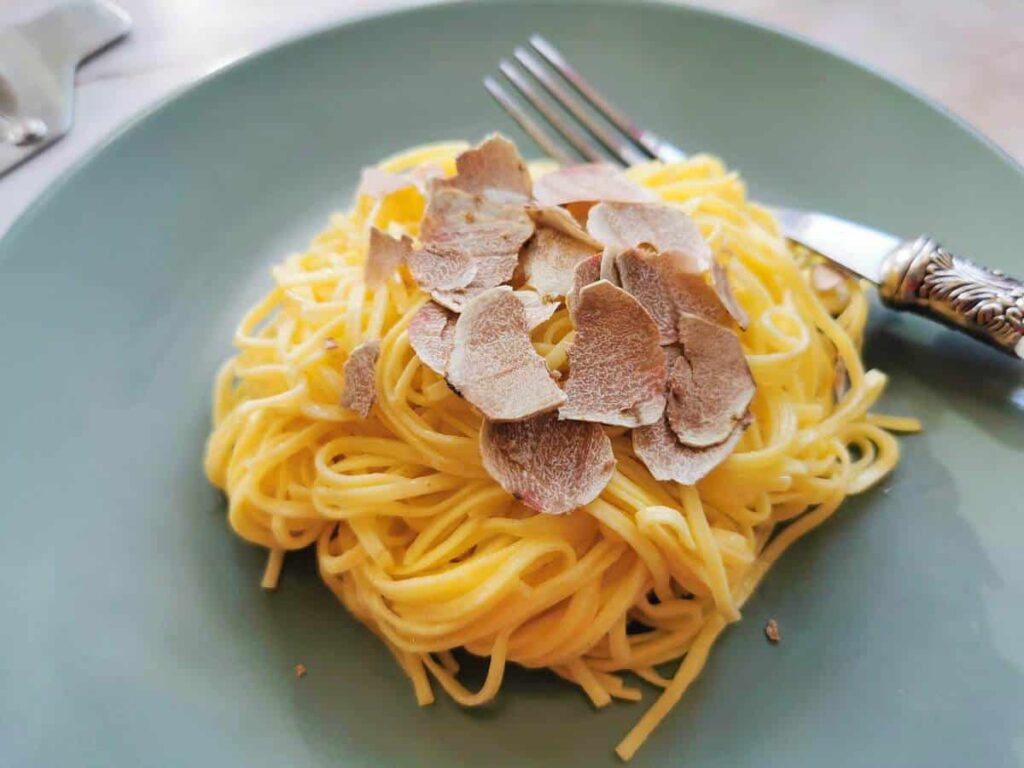
33) Taglierini
Taglierini is a type of Italian pasta known for its long, thin, ribbon-like structure. It is similar to tagliatelle but noticeably thinner. The pasta is made using simple ingredients: eggs, flour, and water. The high ratio of egg yolks to flour gives taglierini an appealing yellow color and a rich flavor.
In Piedmont, Italy, this pasta is called tajarin. It’s often prepared with the deep orange yolks of local eggs, making it unique to the region. Taglierini is versatile and works well with various sauces. It pairs especially well with light sauces, such as butter and sage or seafood combinations.
You can also enjoy taglierini with truffle oil, especially during truffle season in Piedmont. This pasta’s delicate texture ensures that it absorbs the flavors well without becoming too heavy. Traditional recipes might include ingredients like beef, tomatoes, pancetta, and white wine, enhancing the taste.
Overall, taglierini is comforting yet light, making it a great option for any meal. Its thin, ribbon-like structure sets it apart from other pastas, and its rich flavor ensures it will be a delightful addition to your pasta repertoire. Try it with your favorite sauce and enjoy its unique qualities.
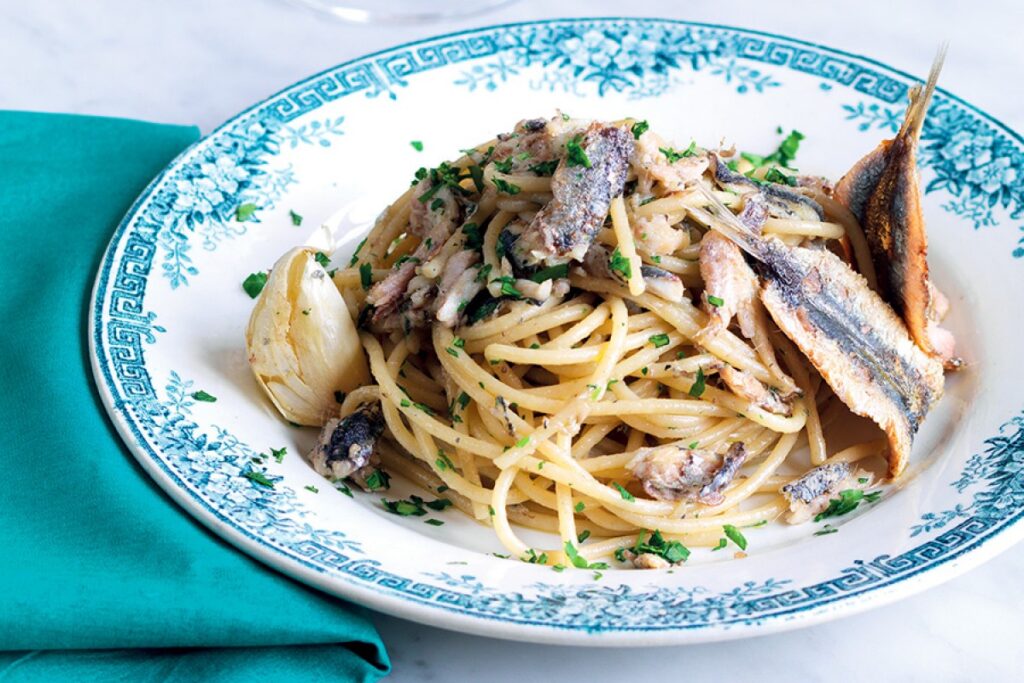
34) Bigoli
Bigoli is a traditional pasta from Veneto, Italy. It is known for its thick, long strands. Originally, it was made with buckwheat flour. Today, it is usually created with whole wheat flour and sometimes duck eggs.
The rough surface of Bigoli helps it hold onto sauces well. It looks like a thicker version of spaghetti. You might find it best with hearty and rich sauces.
This pasta dates back to the 1600s. Legend says it was invented by a pasta maker named Abbondanza in Padua. Bigoli’s shape is achieved using a tool called a bigolaro.
When cooking Bigoli, you can experiment with different sauces. Try it with meat-based sauces or even creamy Alfredo. Its hearty nature makes it versatile for many types of dishes.
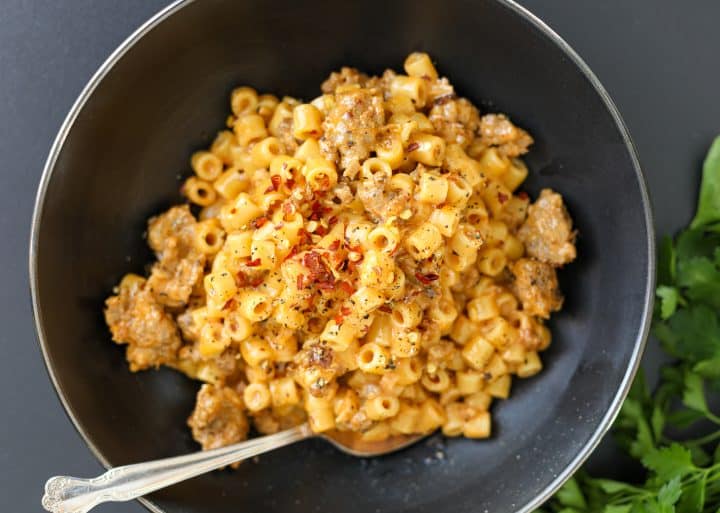
35) Ditalini
Ditalini is a small tube-shaped pasta often used in soups and salads. Its name comes from the Italian word for “small thimbles,” reflecting its size and shape.
You can find ditalini in many classic Italian dishes. It’s especially popular in pasta e fagioli, a hearty soup made with beans and vegetables.
The small size of ditalini makes it perfect for absorbing flavors from broths and sauces. This pasta works well in cold salads too, bringing texture and substance to the mix without overwhelming other ingredients.
When cooking ditalini, use a large pot of salted water and stir occasionally to prevent sticking. Around 1 tablespoon of salt per gallon of water helps to enhance the pasta’s flavor.
Ditalini pairs well with a variety of dressings and vinaigrettes, making it a versatile ingredient for different cuisines. Whether in a tangy Greek pasta salad or a simple Italian soup, ditalini adds a delightful bite to your meals.
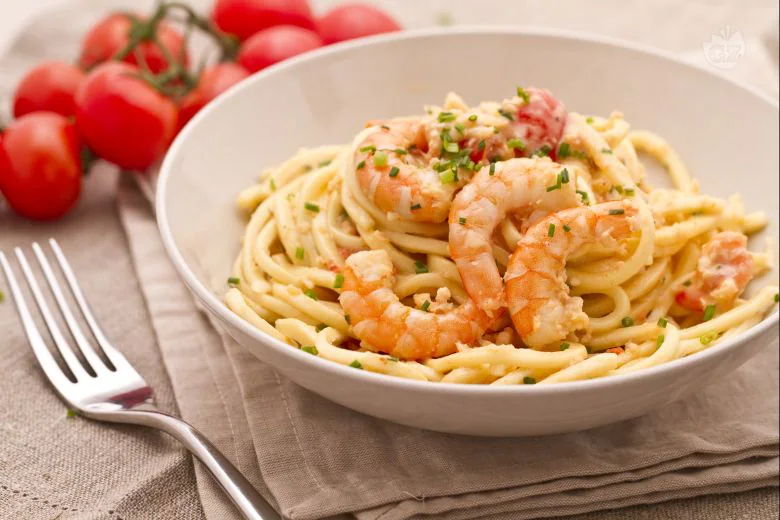
36) Troccoli
Troccoli is a traditional pasta from Puglia, a region in southern Italy. It’s made from durum wheat flour and water, sometimes with eggs included in the dough. This pasta looks similar to spaghetti, but it’s thicker and often has a square or oval cross-section.
To make troccoli, you need a special rolling pin called a “troccolo.” This tool gives the pasta its unique shape. The dough is rolled out and then cut into strands using the troccolo.
Troccoli is often paired with hearty sauces. You can serve it with tomato-based sauces, seafood, or even with simple garlic and olive oil. This pasta holds onto sauces well, making each bite flavorful.
When cooking troccoli, you should boil it in salted water. It takes a bit longer to cook than thinner pastas due to its thickness. This pasta type offers a delightful chewy texture.
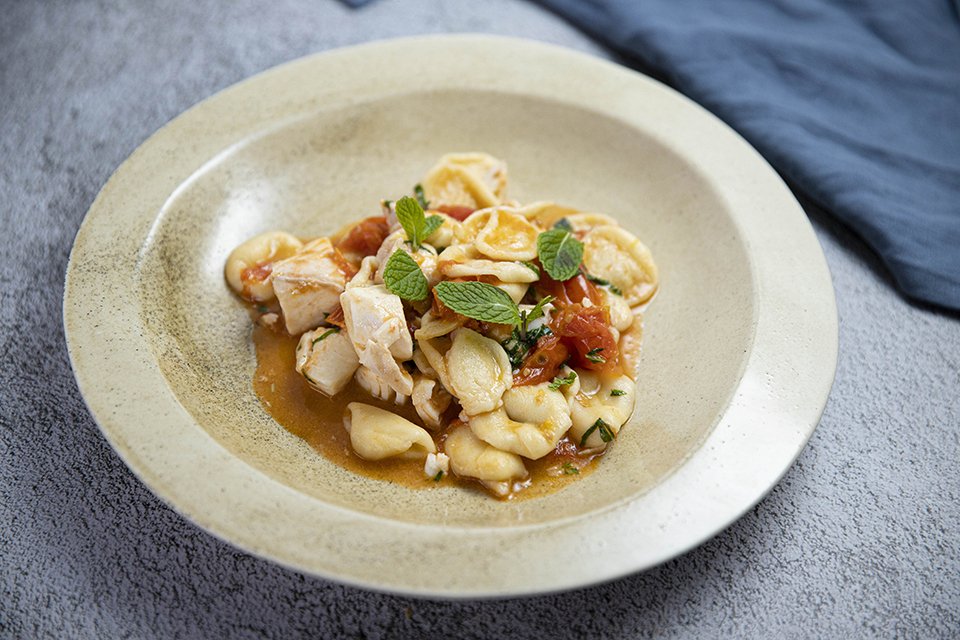
37) Cencioni
Cencioni is a unique type of Italian pasta. It is oval and petal-shaped, with a slight curve. One side has a rough texture to help sauces cling better. The other side is smooth.
Made from semolina flour and water, cencioni has a dense texture. This pasta is larger and flatter than orecchiette.
You should cook cencioni in a large pan with plenty of water. This helps to prevent the pasta from sticking together. Cencioni pairs well with meat ragus or stews. You can also try it with different sauces for a fun variation.
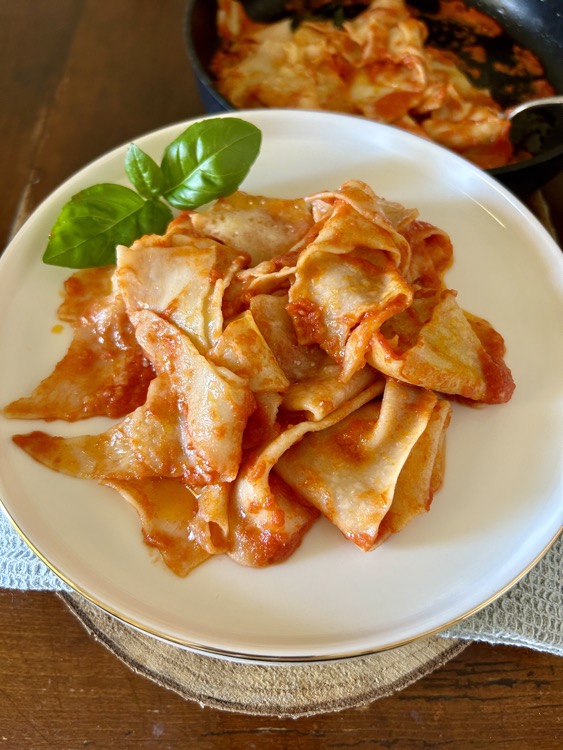
38) Maltagliati
Maltagliati, which translates to “badly cut” in Italian, is a unique type of pasta. The name comes from the irregular shapes of the pasta pieces. These pieces are often made from leftover dough used for other pasta like tagliatelle or ravioli.
You will find that Maltagliati is popular in soups, such as minestrone or pasta e fagioli (pasta and beans). The uneven shapes make it perfect for these dishes, as they capture and hold onto the flavors of the broth.
Making Maltagliati involves mixing flour with eggs and salt until a dough forms. You then knead the dough and roll it out before cutting it into irregular pieces. This results in a rustic and handmade look.
While Maltagliati is excellent for soups, it is not ideal for baked pasta dishes due to its irregular shapes. These can cause uneven cooking, which may affect the dish’s consistency. If you enjoy experimenting with pasta, Maltagliati offers a delightful change from the more uniform shapes.
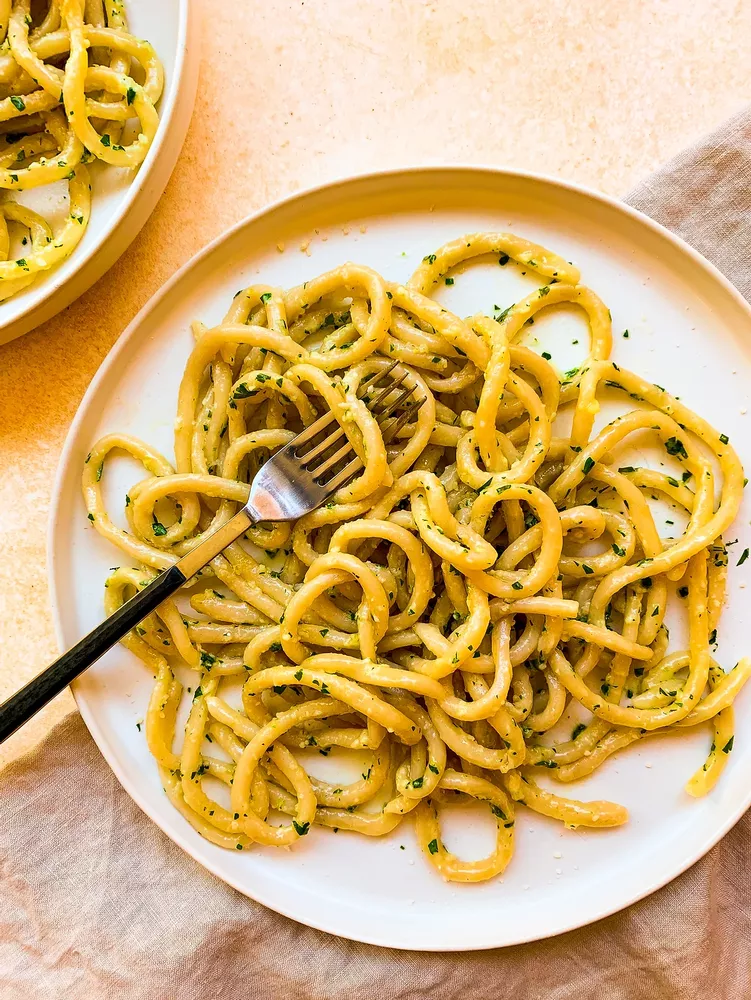
39) Pici
Pici is a thick, hand-rolled pasta from Tuscany.
You make it with flour, water, and sometimes olive oil or egg. This simple dough is rolled into long, thick strands, similar to fat spaghetti. It doesn’t require any special tools, just your hands and a clean work surface.
The texture of Pici is chewy and satisfying. It pairs well with hearty sauces. Traditionally, it is served with Aglione sauce, made from tomatoes and garlic. Other popular pairings include ragù, a meat-based sauce, or cacio e pepe, a mix of cheese and black pepper.
Pici’s rustic look and homemade feel make it a favorite in Tuscan cuisine. Each strand is unique, which adds to its charm. Consider trying Pici if you’re looking for a pasta that stands out both in flavor and presentation.
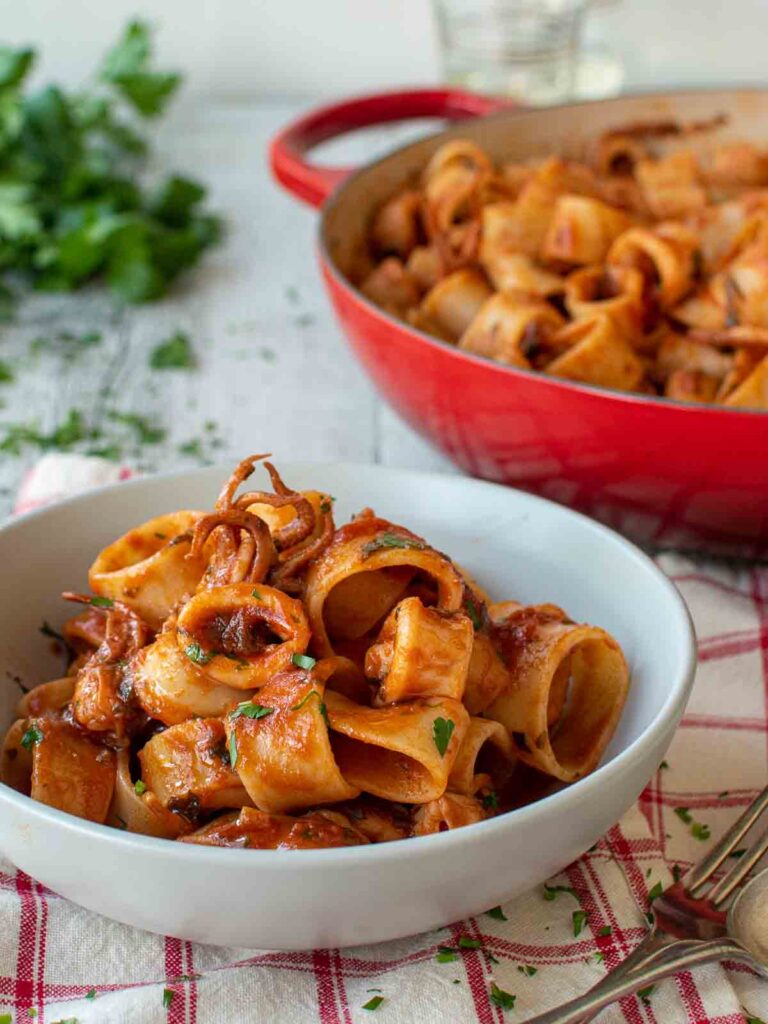
40) Calamarata
Calamarata pasta gets its name from its shape, which looks like rings of calamari. This pasta is perfect for seafood dishes because of its size and texture.
You usually cook Calamarata with fresh calamari, tomato sauce, garlic, and a splash of white wine. The wine adds a nice flavor, and the tomato sauce makes it rich and savory.
Cook the pasta al dente in salted water. Keep some of the pasta water to help mix the sauce. Combine the pasta with the calamari sauce. The sauce should be thick enough to cling to the pasta rings.
This pasta pairs well with a simple green salad and a glass of white wine. Enjoy it while it’s hot for the best flavor.
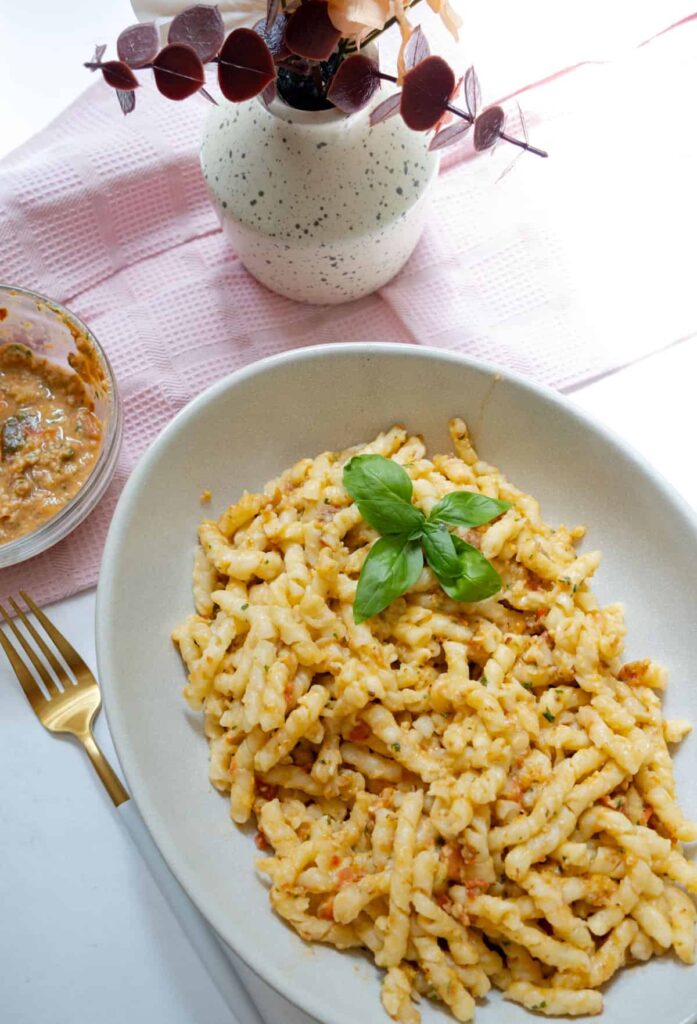
41) Busiate
Busiate is a unique type of pasta originating from Sicily. It is known for its spiral shape, similar to a loosely coiled telephone cord. This pasta is traditionally made by wrapping dough strips around a thin rod, like a knitting needle, to create its distinct shape.
Busiate pairs well with a variety of sauces, particularly those with chunky vegetables, seafood, or simple tomato-based sauces. The spiral grooves help catch and hold onto the sauce, ensuring a flavorful bite every time.
You will often see busiate served with “Pesto alla Trapanese,” a Sicilian variation of pesto made with tomatoes, almonds, garlic, and fresh basil. This combination brings out the best in the pasta’s texture and shape.
When cooking busiate, it’s important to ensure it remains al dente. The firm texture complements the hearty sauces it’s typically paired with, offering a satisfying chewiness.
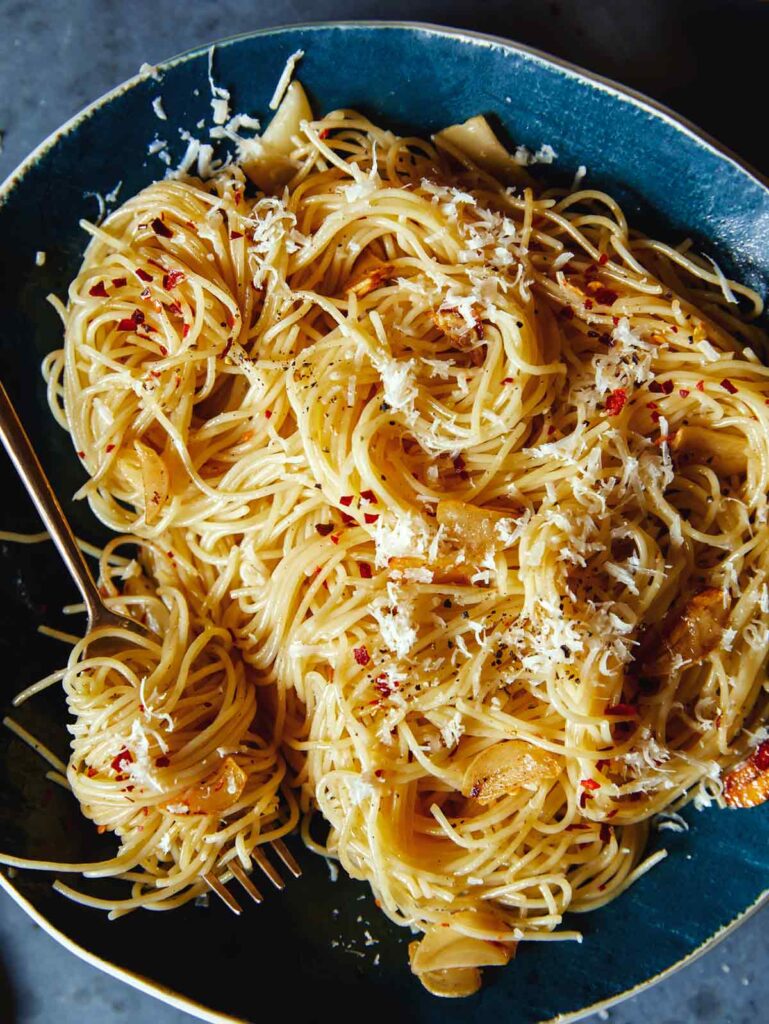
42) Capellini
Capellini is a type of Italian pasta known for its very thin strands. Its name translates to “little hairs” in English, which is a fitting description. The diameter of capellini ranges from 0.85 to 0.92 millimeters, making it finer than both spaghetti and angel hair pasta.
Because of its delicate size, capellini cooks quickly, usually in just 2-4 minutes. It’s best paired with light, simple sauces that don’t overpower its texture. Common choices include garlic and olive oil, or a zesty lemon and butter sauce.
You can also serve capellini with fresh tomatoes and basil for a refreshing summer dish. The thin strands easily absorb the flavors, creating a light and tasty meal. Due to its versatility, you can experiment with various ingredients like seafood, vegetables, or light cream sauces.
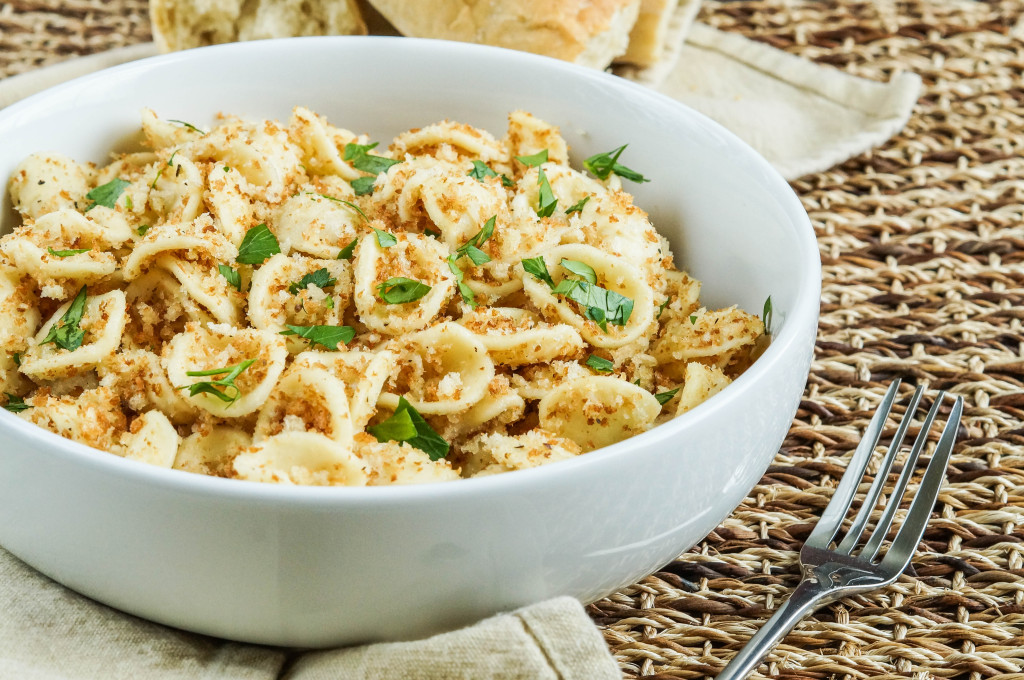
43) Strascinati
Strascinati is an Italian pasta from the southern regions of Basilicata and Puglia. It is made using semolina flour and water. The pasta’s name comes from “strascinare,” which means to pull. This is because you shape the pasta by pulling small pieces of dough.
Strascinati looks similar to orecchiette but is slightly larger. The shape helps it hold sauces well. It can be served with many kinds of sauces, from simple tomato to hearty meat sauces.
To make Strascinati at home, knead durum wheat flour with water and a pinch of salt. Shape the dough by pulling it into small pieces. Cook it in boiling water until it’s tender. Enjoy experimenting with different toppings and sauces.
Strascinati is a versatile pasta that fits well with various dishes.
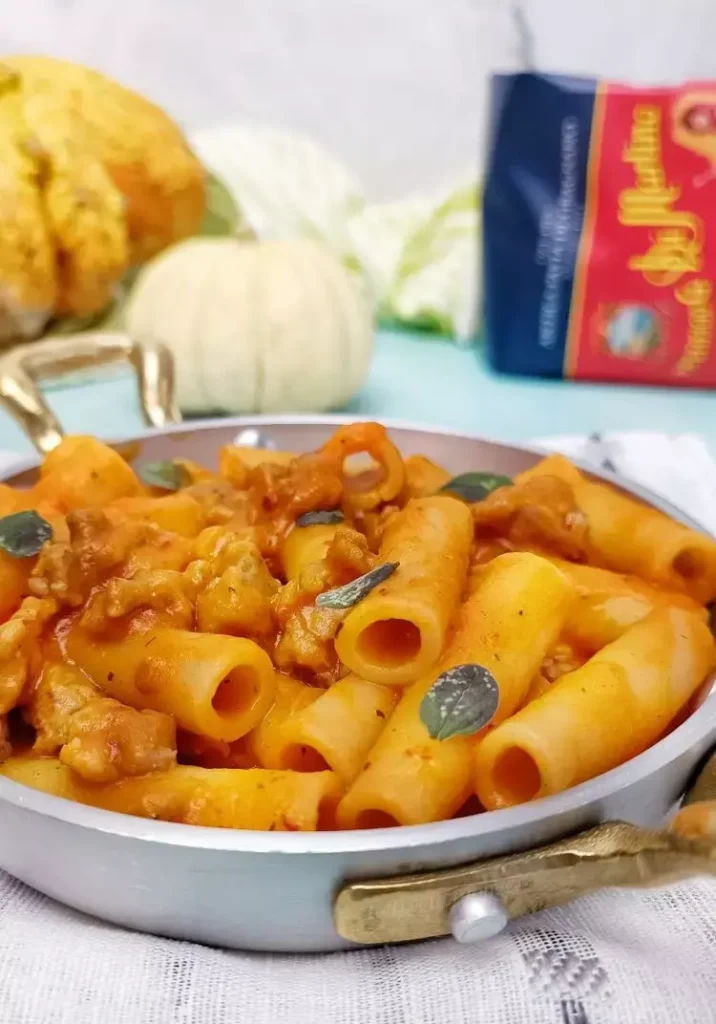
44) Zitoni
Zitoni is a traditional Italian pasta that is particularly popular in Naples and Sicily. It is a large, tubular pasta that is wider than ziti, but the length is usually the same. This pasta is ideal for hearty dishes that require a pasta that can hold up to thick, rich sauces.
You may recognize its close relative, ziti, which is often used in baked pasta dishes. Zitoni’s size and shape make it perfect for absorbing flavors from robust meat or vegetable sauces. It is also ideal for slow-cooked dishes where the pasta can soak up delicious juices over time.
Traditionally, zitoni was served during special occasions and holidays. It was a favorite at weddings in Southern Italy. The name comes from the Italian word “zitelle,” meaning “single woman,” reflecting its customary use in celebratory meals.
Whether you are making a classic ragu alla Genovese, a rich meat sauce involving a long, slow cooking process, or another hearty recipe, zitoni can handle the job. Its wide diameter lets it hold onto plenty of sauce, making every bite full of flavor. Try experimenting with different recipes to see which ones you enjoy most with this versatile pasta.
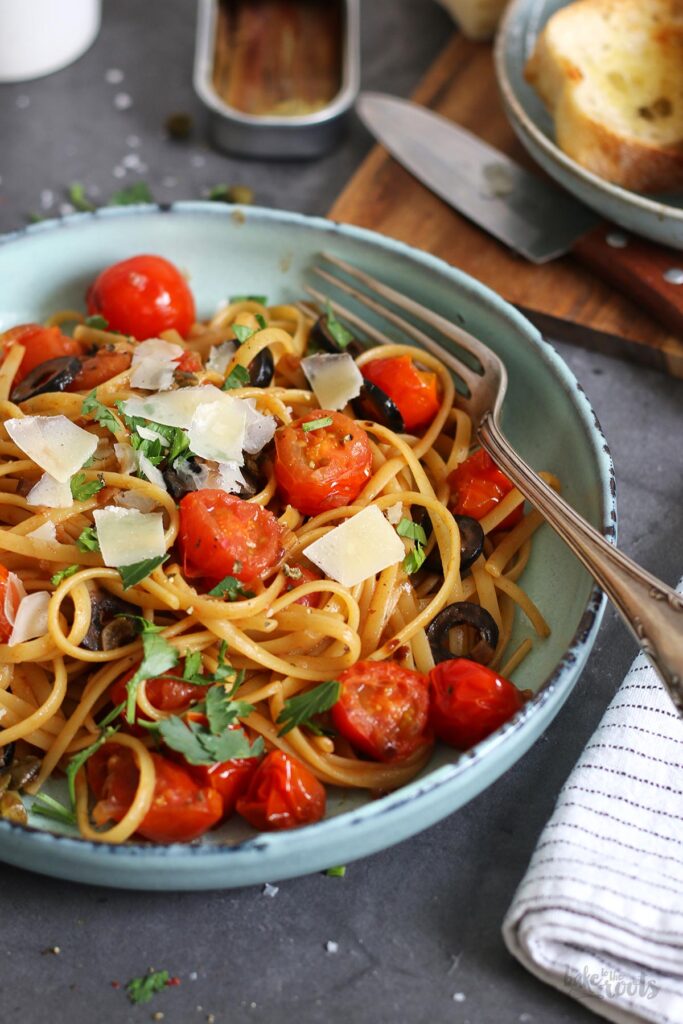
45) Bavette
Bavette is a type of long pasta originating from Genoa, Italy. It is similar to spaghetti but has a flattened shape. This allows it to hold sauce well, making it a great choice for flavorful dishes.
The pasta is made from durum wheat flour and water, providing a firm texture when cooked. Its slender, flat strands are narrower than tagliatelle but slightly thicker than linguine.
When cooking bavette, aim for a texture that is tender yet firm. Bavette pairs wonderfully with pesto, vegetable sauces, and seafood sauces. The convex shape helps sauces cling to the pasta, enhancing the overall flavor.
You might find bavette recipes featuring simple ingredients like garlic, olive oil, and fresh herbs. This pasta variety also fits well in dishes with more complex sauces, adding a pleasant texture to every bite.
History of Italian Pasta
Italian pasta has a rich history that dates back to ancient times, with regional variations making it unique across Italy. From its origins to its evolution, pasta has been a staple in Italian cuisine.
Origins and Evolution
Pasta’s history can be traced back to ancient times. The earliest evidence of pasta comes from the Etrusco-Roman era, where a dish called lagane was made from durum wheat. This early form of pasta, however, was oven-baked rather than boiled.
In the Middle Ages, pasta became more popular across Italy. It was during this time that new techniques and tools, such as the use of an extruder, were developed to help shape pasta into various forms. By the 13th century, pasta had become a dietary staple.
During the 19th century, Italian immigrants brought pasta to the United States, helping to popularize it worldwide. Today, pasta is enjoyed globally in a myriad of shapes and sizes, each serving a unique purpose in culinary applications.
Regional Variations
Italy’s diverse regions have each contributed their own unique pasta styles. In the north, you’ll find egg-based pasta like tagliatelle and pappardelle, often paired with rich meat sauces.
In central Italy, pici, a thick hand-rolled pasta, is popular. This pasta is commonly served with ragu or game meats like wild boar.
Southern Italy offers pasta like orecchiette, which means “little ears,” from the region of Puglia. This pasta is typically made from durum wheat and pairs well with broccoli rabe and sausage.
Each region’s climate, agriculture, and history have influenced the types of pasta made, resulting in diverse textures, shapes, and flavors that are a true reflection of Italy’s rich culinary heritage.
Nutritional Benefits
Italian pasta is not only delicious but also offers various nutritional benefits. Understanding its macronutrients and micronutrients, as well as its health considerations, can help you make informed choices.
Macronutrients and Micronutrients
Pasta is a good source of carbohydrates, which provide energy for your day-to-day activities. A typical serving contains about 34 grams of carbohydrates. It also has around 8 grams of fiber, which aids digestion and helps keep you feeling full.
Proteins in pasta are essential for muscle repair and growth. Whole wheat pasta has approximately 7.5 grams of protein per serving. It is low in fat, with only about 4 grams of fat and 0.5 grams of saturated fat.
Pasta also contains micronutrients like B vitamins (thiamine, riboflavin, niacin), iron, and magnesium. These nutrients are important for energy metabolism, oxygen transport, and muscle function. Whole grain pasta often has higher amounts of these vitamins and minerals compared to refined pasta.
Health Considerations
When choosing pasta, whole grain options are generally healthier. Whole grain pasta is lower in calories and carbohydrates. It also has more fiber, which helps with digestion and keeps you full longer. Eating whole grains has been linked to a lower risk of obesity and related health issues.
It’s important to watch portion sizes. Overeating pasta might lead to consuming extra calories, which can be counterproductive if you are trying to maintain or lose weight. Pairing pasta with vegetables, lean proteins, and healthy fats can make your meal more balanced.
In summary, pasta can fit well into a healthy diet if you pay attention to portion sizes and choose whole grain options whenever possible.
Cooking Techniques
When cooking pasta, the method you use can significantly affect the final dish. Mastering boiling pasta and pairing it with the right sauces is key to making a memorable meal.
Boiling Pasta
Boiling pasta is straightforward but requires attention. Begin by using a large pot filled with plenty of water. For every pound of pasta, use about 4 quarts of water.
Add a generous amount of salt—about 1-2 tablespoons per pound of pasta. This enhances the pasta’s flavor. Bring the water to a rolling boil before adding the pasta.
Stir the pasta occasionally to prevent sticking. Cooking times vary, so check the pasta package for the recommended time. Typically, it ranges from 8-12 minutes for most types. Taste the pasta a minute before the suggested time to ensure it’s al dente, which means it should be firm but not hard.
Once cooked, immediately drain the pasta, reserving some of the cooking water. This starchy water can be used to adjust the consistency of your sauce later.
Pairing Pasta with Sauces
Choosing the right sauce for your pasta can elevate your dish. Different pasta shapes are designed to hold various types of sauces effectively.
Long pasta like spaghetti or linguine is best with light, olive oil-based sauces or tomato sauces because the thin strands can be evenly coated without being overwhelmed.
Short pasta like penne or rigatoni pairs well with chunky sauces or ones with larger ingredients, such as meat or vegetables. The ridges help trap the sauce, ensuring every bite is flavorful.
Stuffed pasta like ravioli or tortellini is often paired with simple, light sauces like sage butter or a light tomato basil sauce to let the filling shine.
Sheet pasta such as lasagna is ideal for baked dishes with rich, hearty sauces and layers of cheese or béchamel.
By understanding these techniques, you can cook pasta that’s both delicious and perfectly paired with its sauce.
Popular Italian Pasta Dishes
Italian cuisine is rich with traditional pasta dishes and innovative modern takes. You’ll see classic recipes like Carbonara celebrated alongside new versions of favorites.
Traditional Recipes
Spaghetti Carbonara stands out as a Roman classic. This dish is made with eggs, cheese (typically Pecorino Romano), pancetta, and pepper. It’s creamy without using cream, which might surprise you.
Lasagna is another well-loved dish. Layers of pasta alternate with rich meat sauce (ragù), cheese, and béchamel. Each ingredient is crucial for the texture and flavor.
Pesto alla Genovese is essential in Ligurian cooking. Basil, garlic, pine nuts, Parmesan, and olive oil create a bright green sauce, traditionally served with trenette or trofie pasta.
Penne all’Arrabbiata translates to “angry penne” due to its spicy tomato sauce, made with garlic, tomatoes, and red chili peppers. It’s a fiery, flavorful dish.
Modern Twists
Modern Italian cuisine often reinvents classic dishes. Zoodles Carbonara replaces spaghetti with spiralized zucchini, offering a low-carb option while keeping the creamy, savory sauce.
Lobster Ravioli adds a luxurious twist to standard ravioli. Filled with lobster meat and often dressed in a creamy, seafood-based sauce, it turns a common dish into an elegant meal.
Pancetta and Pea Risotto combines the traditional risotto technique with modern ingredients like crispy pancetta and fresh peas. It balances richness and freshness perfectly.
Bacon-Wrapped Gnocchi innovates traditional potato gnocchi. Wrapping each piece in bacon before baking adds a crispy, smoky element, giving this classic a new dimension.
These approaches show how Italian pasta dishes can evolve while still honoring their roots.
